Exciting news from this week is that GLC's site renovation plans are now out there, for the public to see! We are pleased to have been interviewed by journalism grad student Maya Smith for her piece that just published in The Wash, an American University paper. Check out the link for the full story!
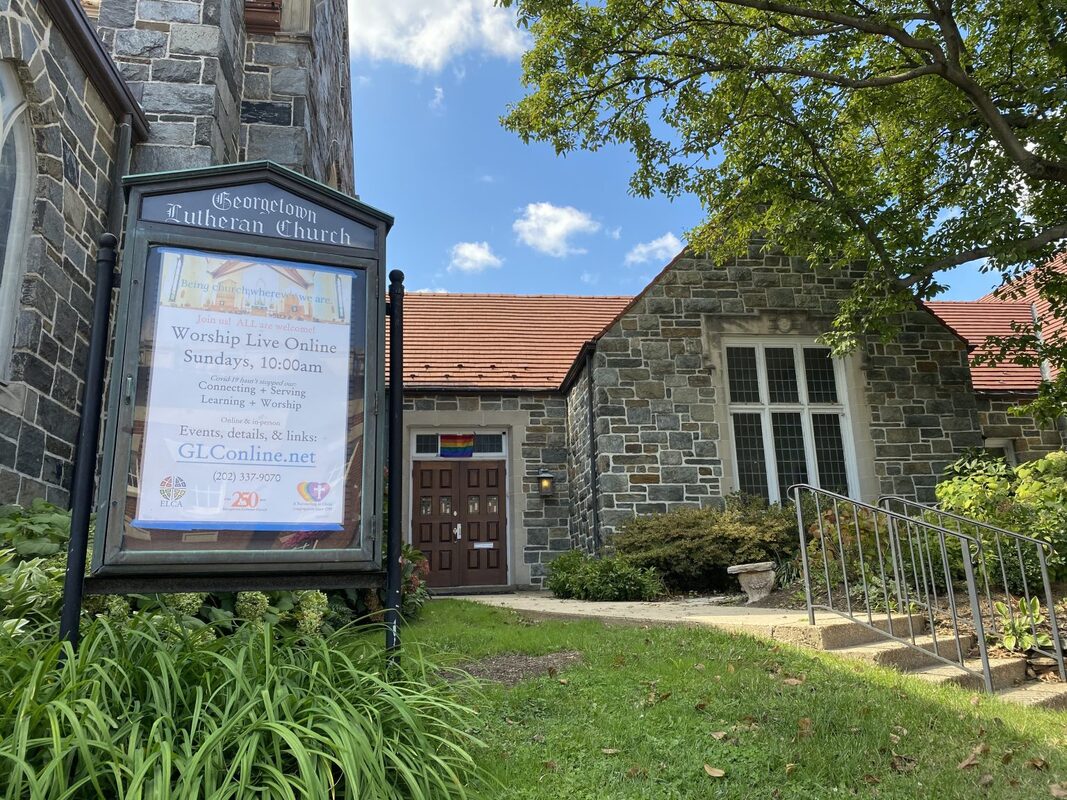
The effects of Covid-19 have been slowing down all of our normally-planned activities, and its economic impact has upended many people's lives. We're very aware of the necessary precautions, and, as a church, we've closed our building and moved to online worship services and meetings for almost six months, now.
Against that backdrop, it was a relief to meet in-person with a small group of congregation and property leaders, to discuss GLC's exterior renovations and our site plan, on Aug 30. We gathered outside, next to the bell tower, with our masks on, to review a draft of the proposal that we hope to send to the Old Georgetown Board this fall. This plan is based directly on congregation ideas and feedback, over the past 18 months! It is very exciting that it's finally taking shape.
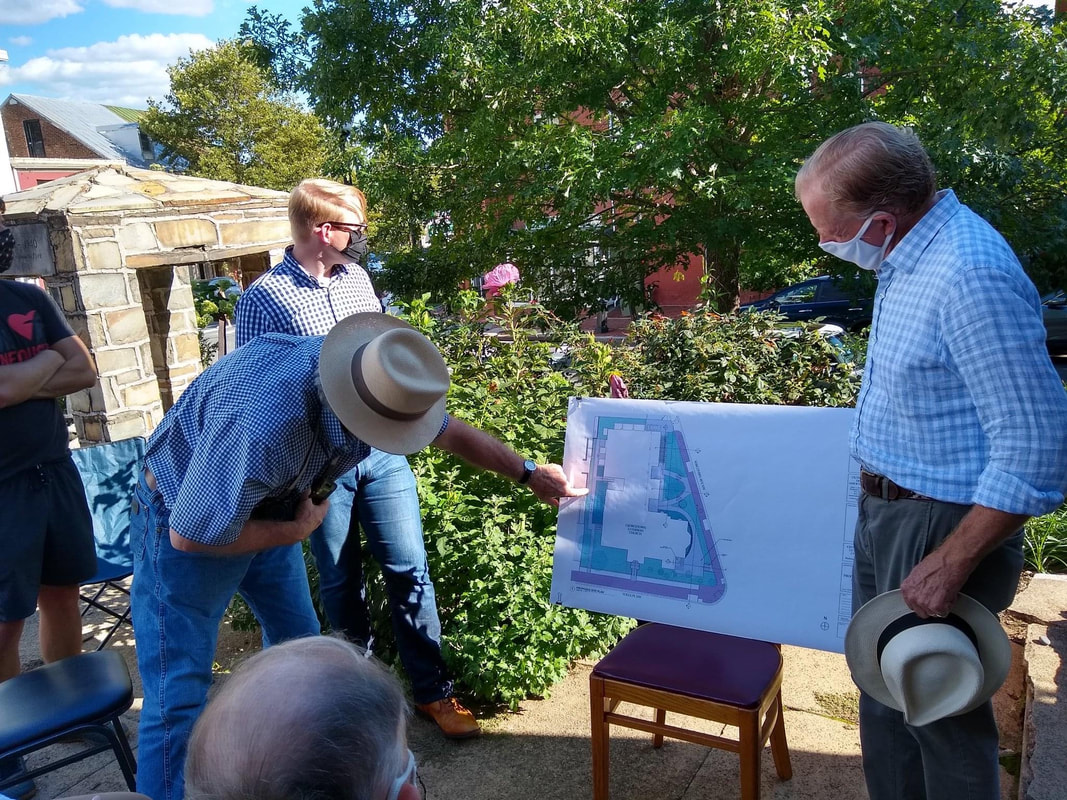
Alexis, Charles, John H (pointing), and our architect, Outerbridge Horsey.
The plan we are developing has several key goals: to restore our bell tower and surrounding gardens to an historically-faithful state of repair; to improve access to the building for strollers and wheelchairs; and to deal with the serious water drainage issues we're seeing on site.
Due to GLC's location in the Georgetown Historic District, there are stringent requirements we need to meet before we can obtain a building permit for these projects. By federal law, two rounds of review are required by the Old Georgetown Board, a division of the U.S. Commission on Fine Arts. GLC will be submitting documentation for a concept review in early October; if that succeeds, we'll then be on track for a permit review in Winter 2020-21.
A copy of GLC's OGB submission can be viewed at this link.
Last fall, we worked with the National Bell Festival to climb and document the state of our historic bell tower. We discovered electric chimes in the belfry, but there is no structure from which to hang the actual bell. Moreover, we know that GLC did not have possession of its bell when the current church was built in 1914 -- it was only returned to us in 1937.
The bell is also in pretty rough shape. It has a crack, which is decades old and has been repaired. It also sat outdoors in the rain for 50+ years in Georgetown, and likely longer when it resided in West Virginia. This has caused a lot of rust to build up.
Armed with this knowledge, we know that the bell can no longer be exposed to the elements, and can't be returned to regular service either. So your GLC leaders decided to take the only possible next step: planning for permanent display of the bell inside the building.
We've received extensive help from the National Bell Festival in this effort, and on April 29, the bell was picked up from GLC for transportation to the B.A. Sunderlin Bellfoundry, in Ruther Glen, Virginia. The foundry will analyze the bell, to determine the severity of the crack. They will also determine its metal composition, age, and whether it bears an inscription linking it to GLC. And finally, they will help us identify how it can be cleaned, restored and displayed here at the church.
You can track the bell's progress at National Bell Festival's site, and check out the photos below.
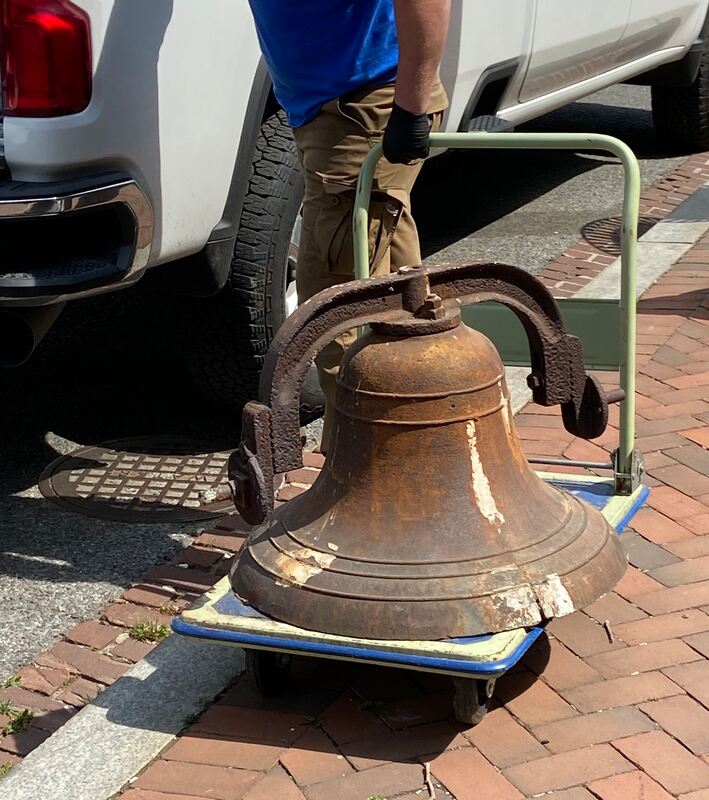
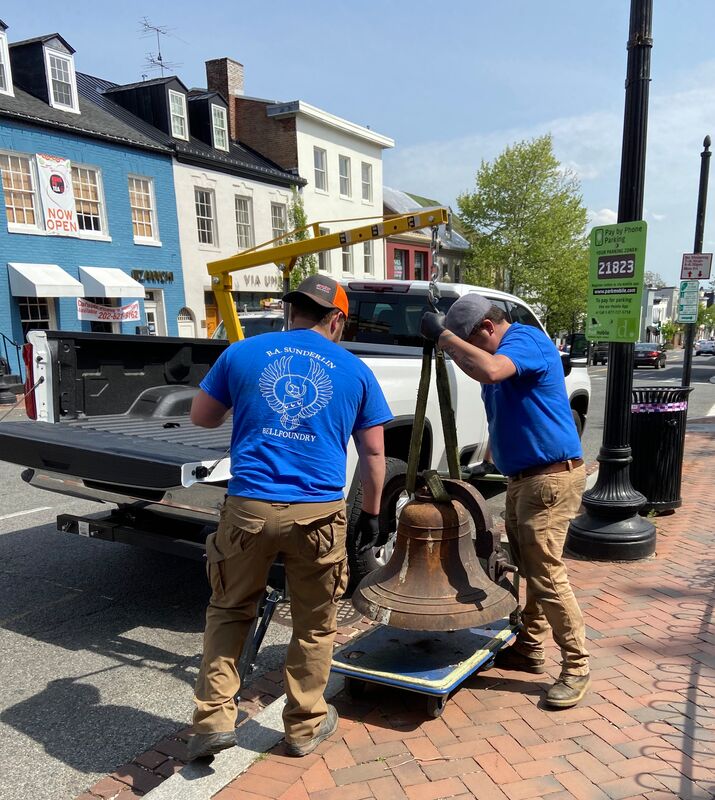
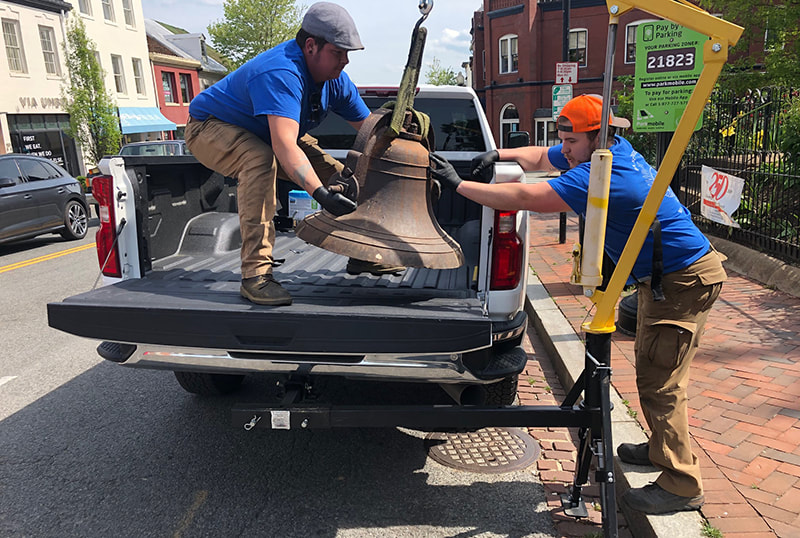
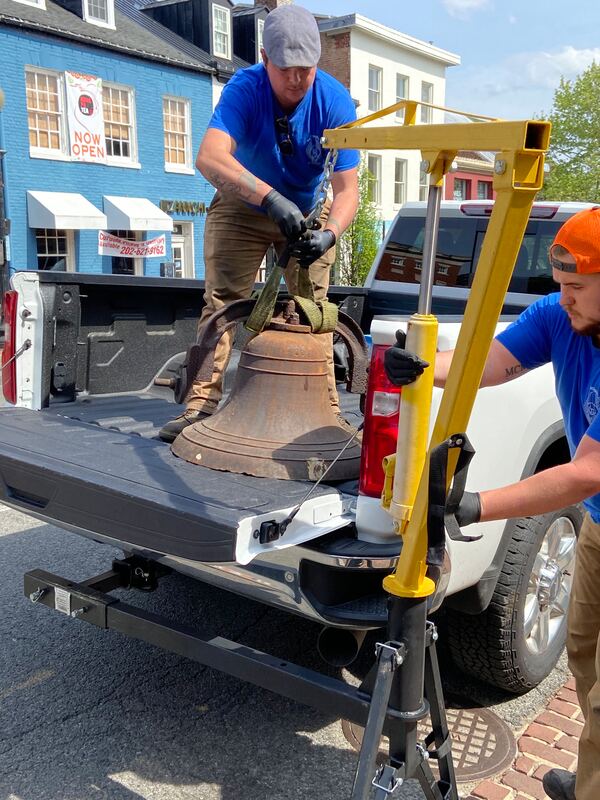
We have celebrated a month since our last major property update, which means your property committee has enjoyed a short break. We've also started planning for the next phases of renovation: the restoration of our belltower, its steps and garden path, and related projects.
As those plans, still very rough, begin to take shape, GLC was very excited to receive an offer from the National Bell Festival, to assist with research and documentation related to our historic bell. As you may know, our historic bell has lived on a cart inside the church for the last 20 years... after the bell structure in our front yard began to deteriorate considerably. We hope to preserve and restore the bell, remove the rust on the outside, and make it usable again by the GLC congregation.
To kick off these bell restoration efforts, and introduce everyone involved, on October 4 we invited a small group of GLC leaders to meet with the board of the Bell Festival, and do something GLC has not done for at least 40 years: Open the hatch and ascend our historic bell tower.
See photos below, and this parallel posting by the National Bell Festival.
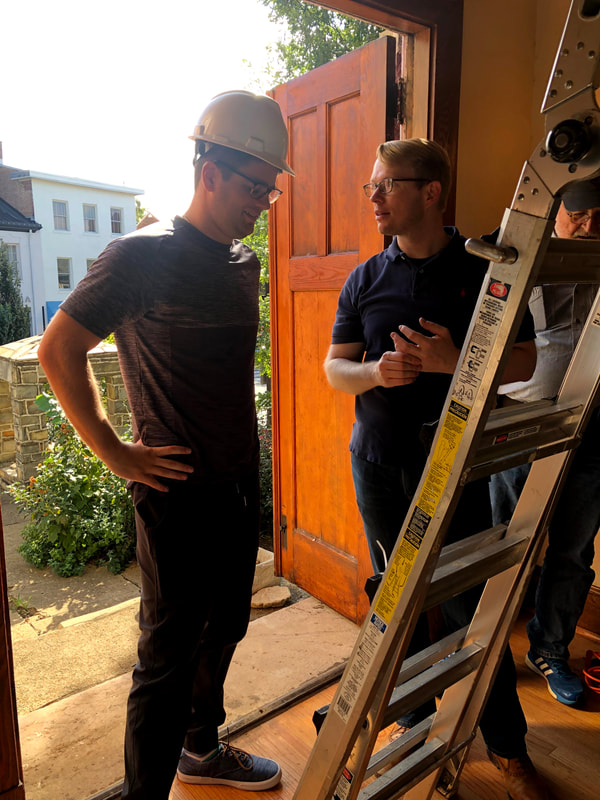 Step 1: Alexis is equipped with a hard hat, and a few words of encouragement from the church council. Guess who's going up first?
Step 1: Alexis is equipped with a hard hat, and a few words of encouragement from the church council. Guess who's going up first?
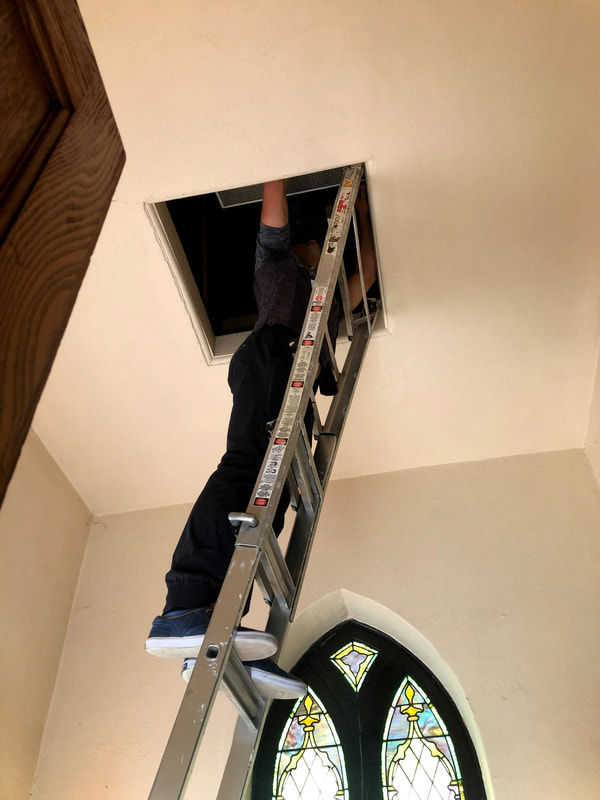 And the hatch is open! For the first time in 40 years!
And the hatch is open! For the first time in 40 years!
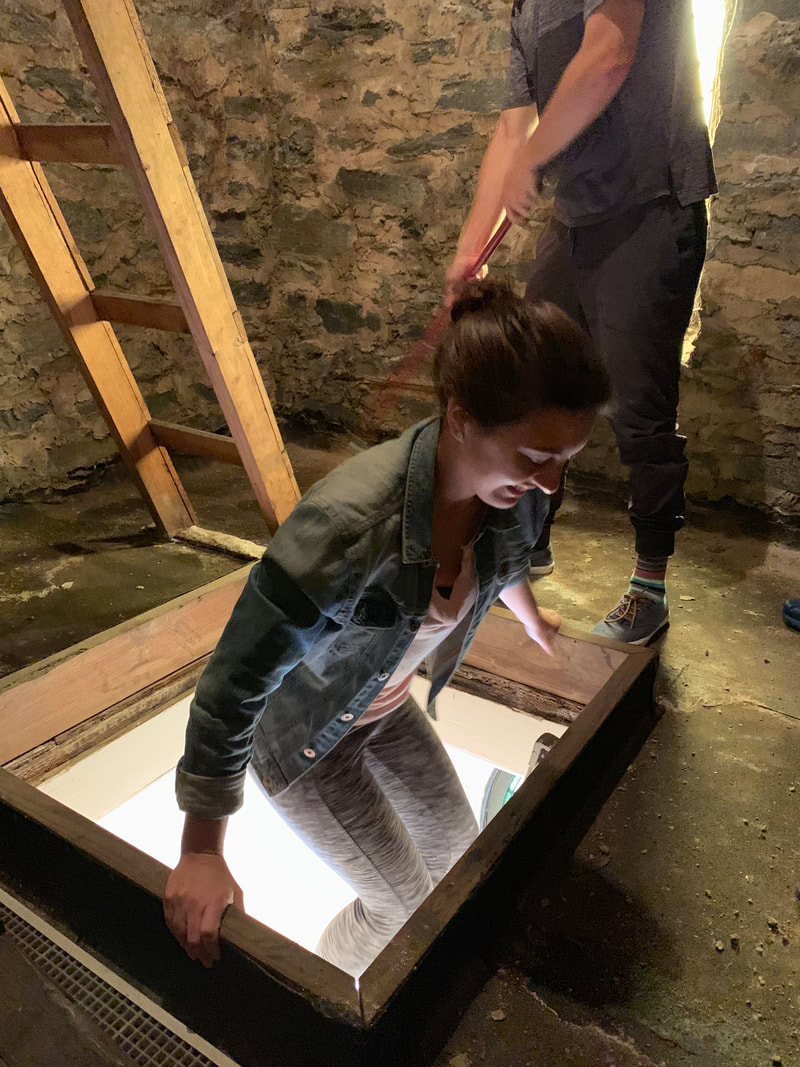 So what's up there? There's a landing, lots of cobwebs, a window, and a functioning light! This is not the belfry, though... it's an intermediate stage. But there's a built-in ladder to the next level...
So what's up there? There's a landing, lots of cobwebs, a window, and a functioning light! This is not the belfry, though... it's an intermediate stage. But there's a built-in ladder to the next level...
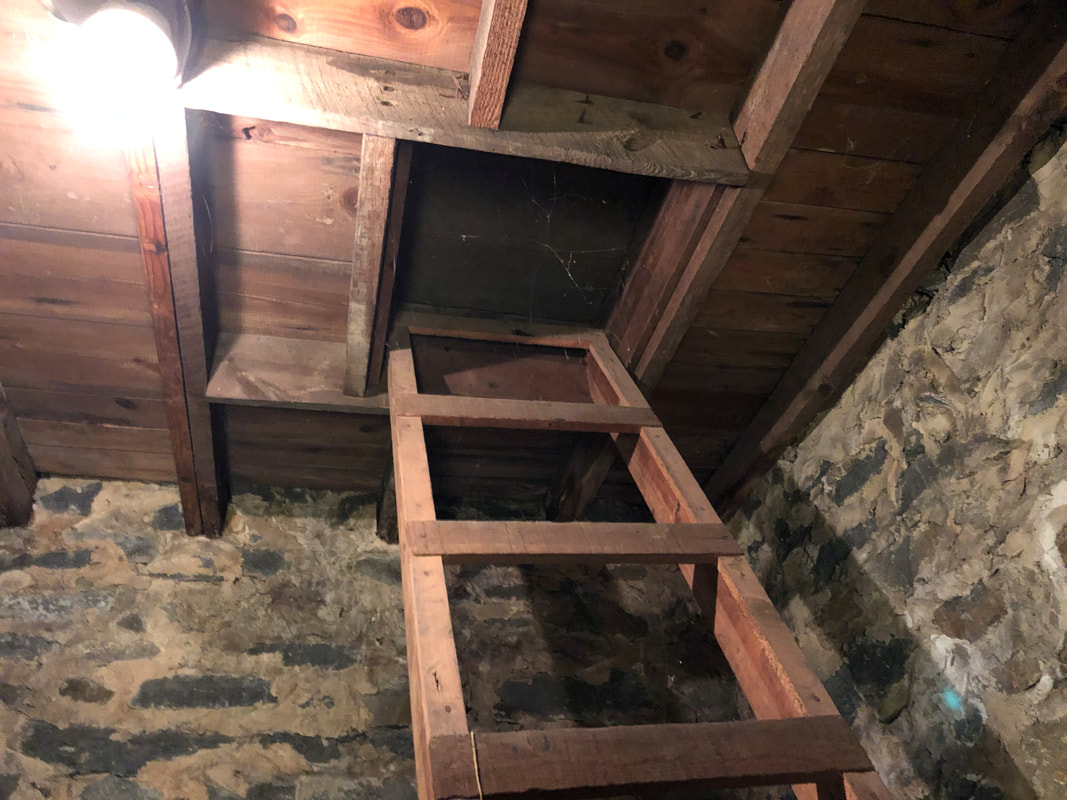 At the top of the ladder, it's another hatch.
At the top of the ladder, it's another hatch.
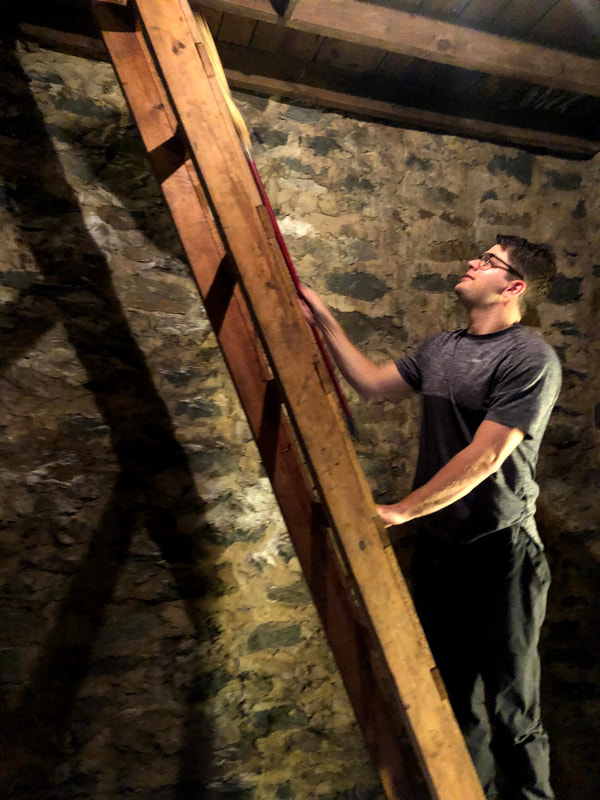 So we continue upward... drum roll...
So we continue upward... drum roll...
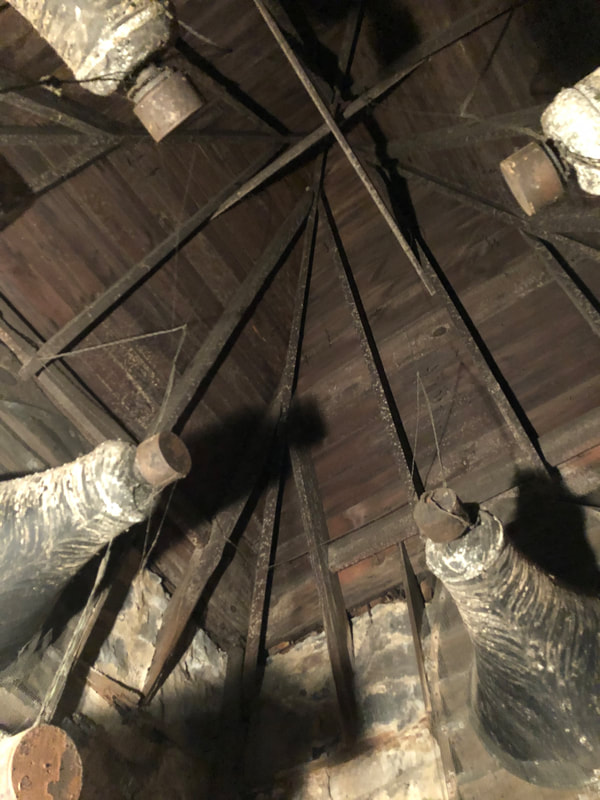 And this is what's up there! It's a 105-year old belfry, with a very old wooden roof, beneath the tiles. Some evidence of pigeons... And -- what are those cone-shaped things? There are seven of them, in total.
And this is what's up there! It's a 105-year old belfry, with a very old wooden roof, beneath the tiles. Some evidence of pigeons... And -- what are those cone-shaped things? There are seven of them, in total.
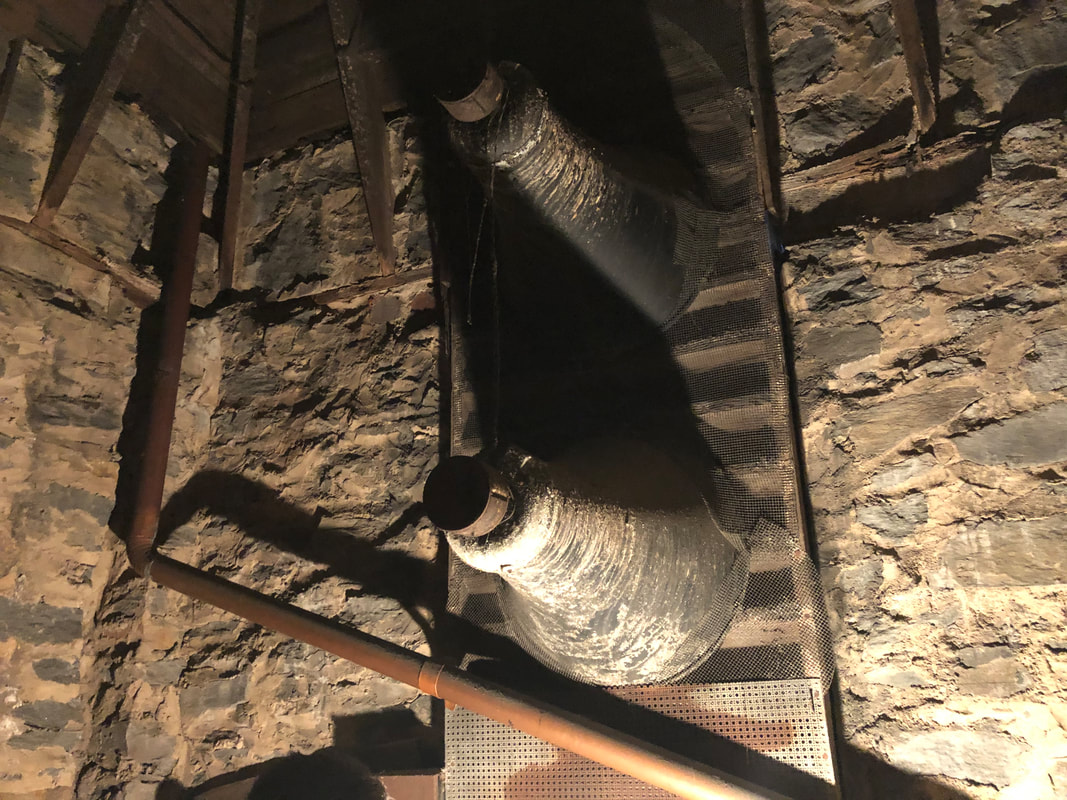 They are electric chimes! The sound would have been produced by the small drum you see. The sound would have been amplified through the bell, and projected outside through our original wood and metal louvers, which are intact behind the sheet-metal coverings you see from the street.
They are electric chimes! The sound would have been produced by the small drum you see. The sound would have been amplified through the bell, and projected outside through our original wood and metal louvers, which are intact behind the sheet-metal coverings you see from the street.
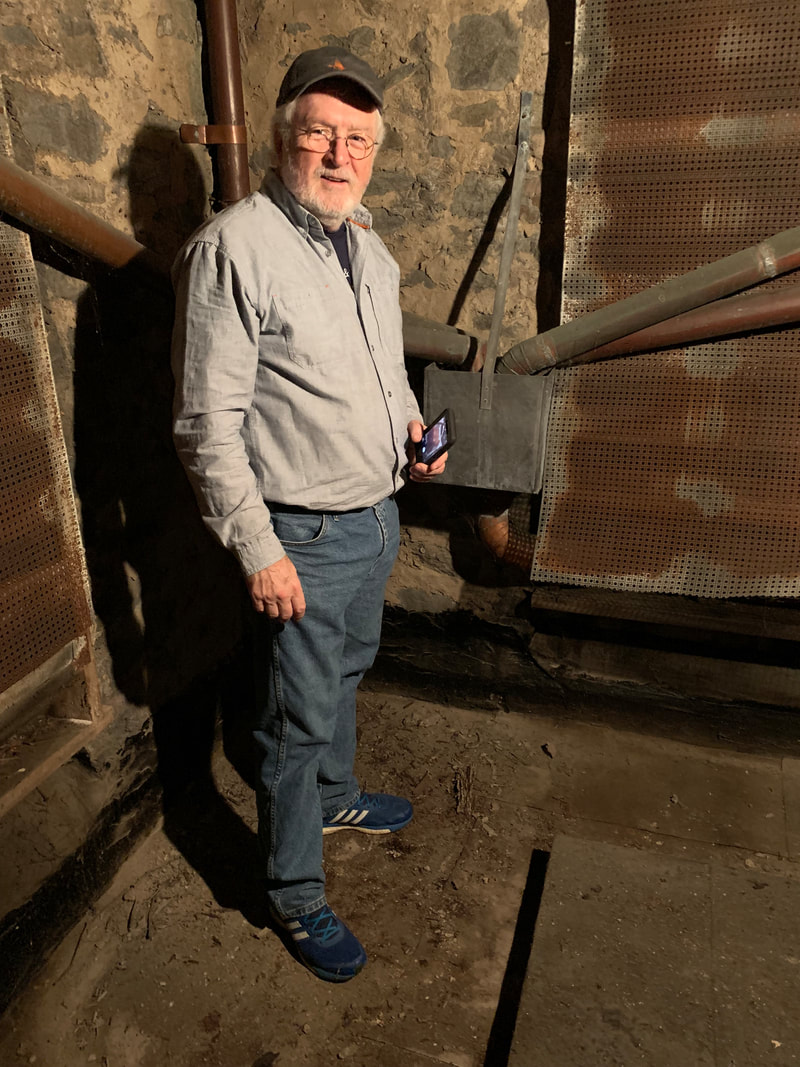 John stands next to a fairly unique drainage system that was built to carry water off of the belltower roof. Pretty exciting day to be on the property committee!
John stands next to a fairly unique drainage system that was built to carry water off of the belltower roof. Pretty exciting day to be on the property committee!
So what did we learn from this? The church's own history is fragmentary, and embellished at times. No one knew what to expect in the bell tower, but everyone was surprised to find old electric chimes.
In retrospect, this makes sense. We know that GLC's historic bell wasn't in our possession when the current building was erected in 1914. It was recovered in 1937 in West Virginia, and eventually installed in a structure in the garden in 1943. Why didn't they hang it in the bell tower? It's impossible to say, and we have no records of that discussion. Perhaps it was too heavy?
Regardless, as we look for answers, we've been re-reading Mamie Scrivener's 1955 history of the church (available on the History page), and noticed this with a new level of attention. Specifically, she talks about, "Chimes costing $3,000 were installed in 1947 from gifts of members," and, on Sunday mornings, "an altar boy... marches up Church center aisle to light the candles while organist plays chimes."
Perhaps we've rediscovered those chimes, which were installed after the church's bell found its permanent home in our garden. This voyage into history has definitely helped us start thinking about the next steps of capital restoration at GLC!
All of the plaster repair work, and subsequent painting, is finished! Work in the sanctuary concluded on September 10, and was immediately followed by a deep-clean of the carpets. Plaster and paint work cost a total of $39,502, which was within our planned budget, but above the initial estimate, due to additional repairs needed to stabilize the walls around the altar. We also exceeded our initial estimate for electrical work, so that we could ensure as many wires as possible are now hidden behind the walls.
The completion isn't a minute too soon, since there is a wedding scheduled for Saturday, September 14!
Final photos are below.
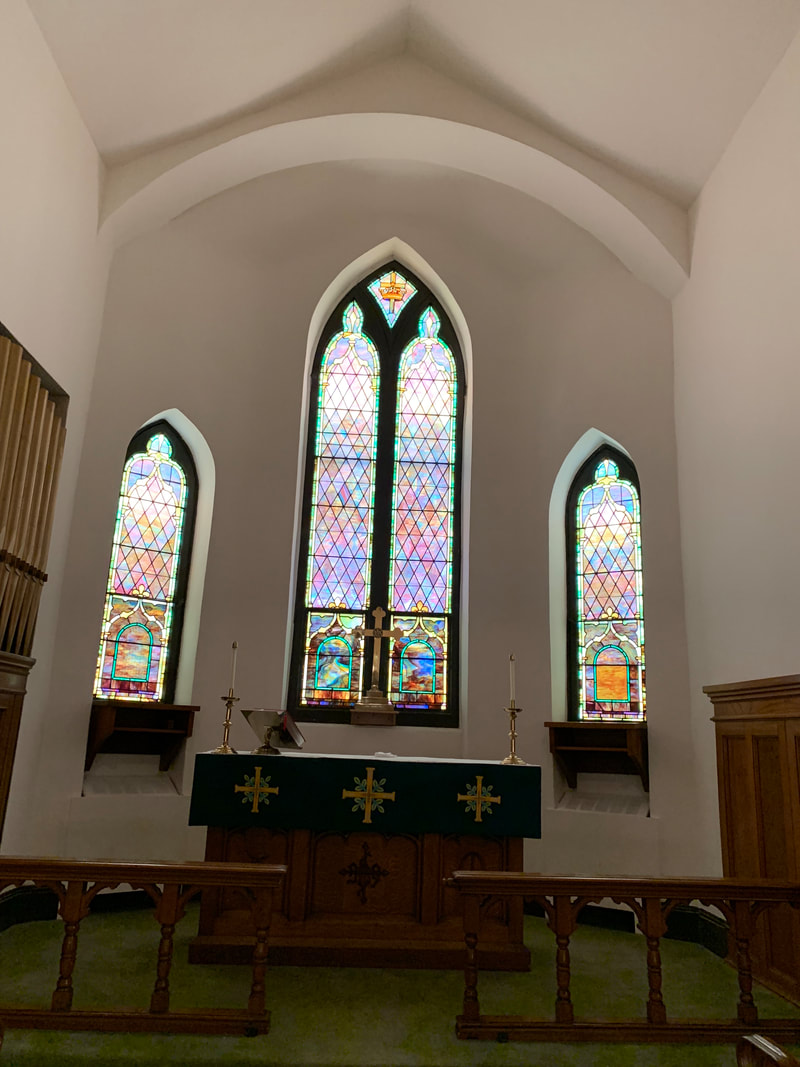
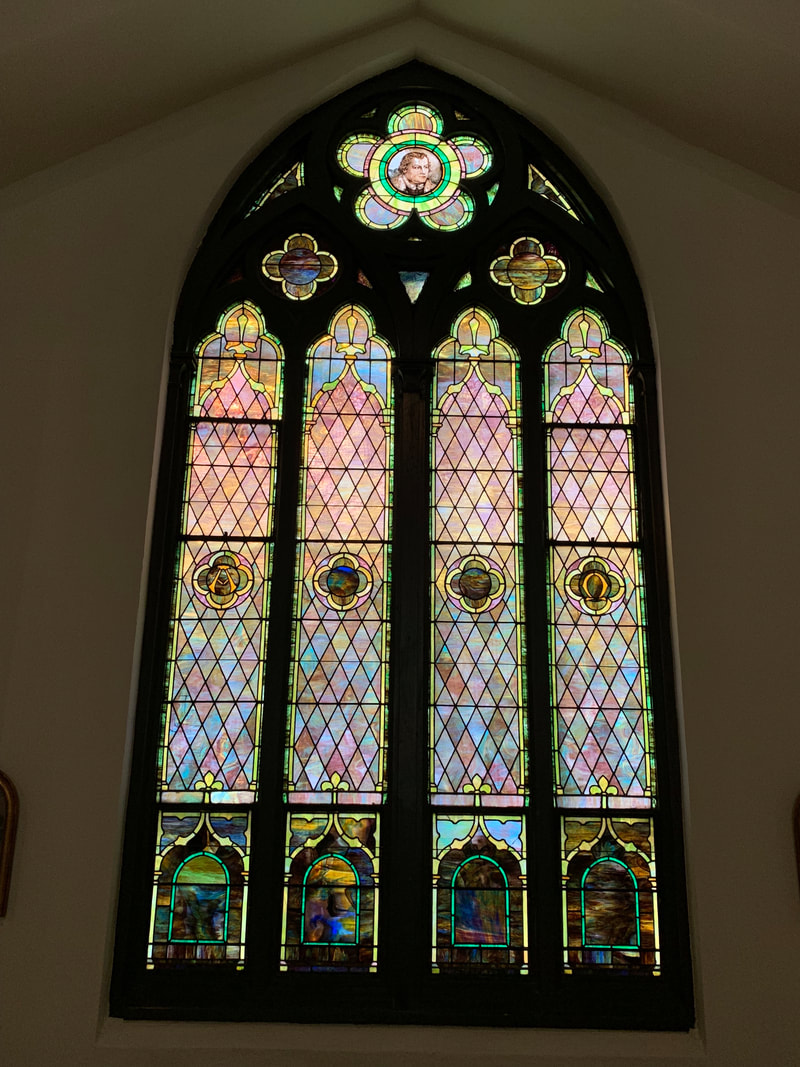
This is a lot of fun to watch! For the past two months, we've held Sunday worship in the Fellowship Hall while the sanctuary plaster and paint are repaired. Here comes our altar, back to its home!
On August 24, we were lucky to have enough volunteers on hand to clean our sanctuary's stained-glass windows! This was a unique opportunity, because the painters' scaffolding and equipment was still on site, allowing us to get up close to the high areas. The windows were coated with decades worth of dust, grime, and sticky wax from all of those candles.
The volunteers also cleaned and reinstalled the ornamental gold pipes located on the front of our 1919 Möller pipe organ (at the front of the sanctuary), which led to some interesting discoveries.
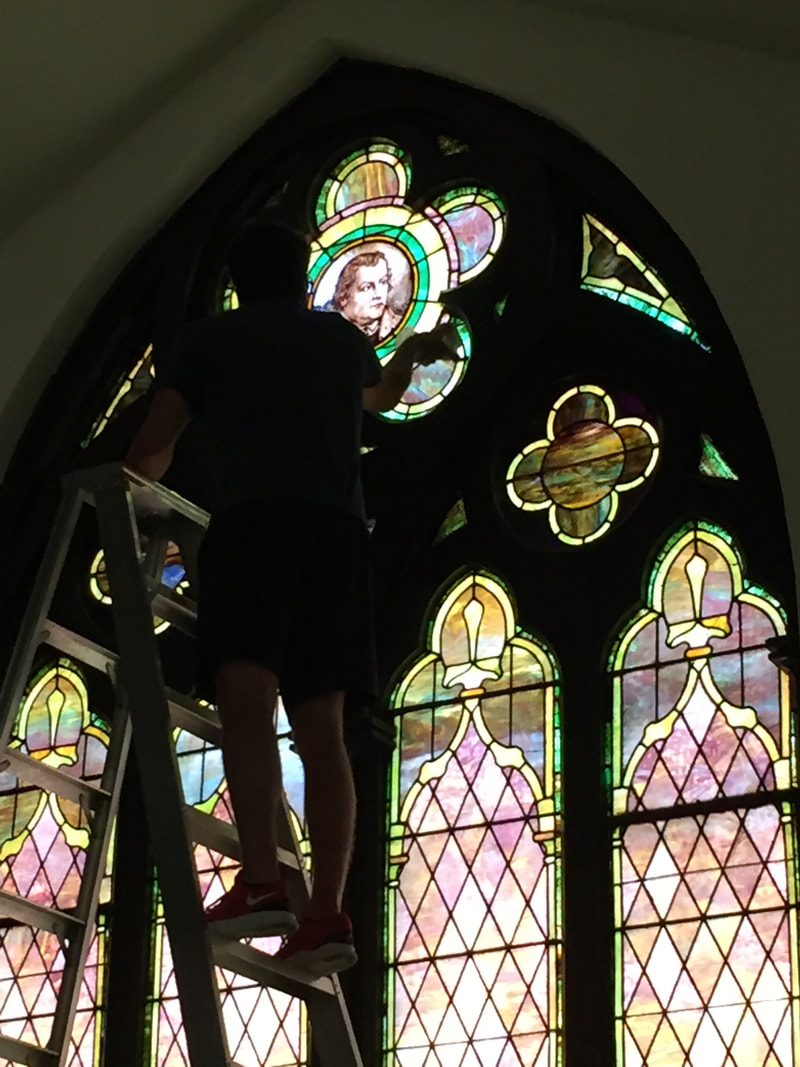 Alexis gets up close and personal with Martin Luther.
Alexis gets up close and personal with Martin Luther.
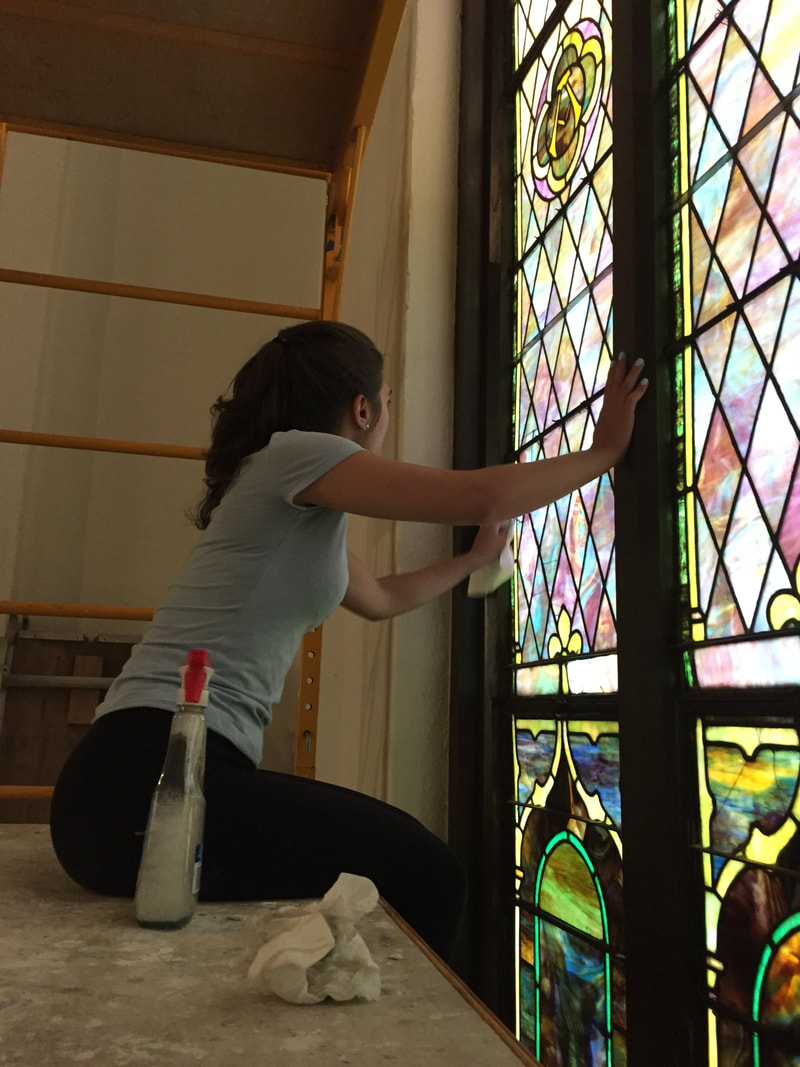 Emma scrubbing away at decades of grime.
Emma scrubbing away at decades of grime.
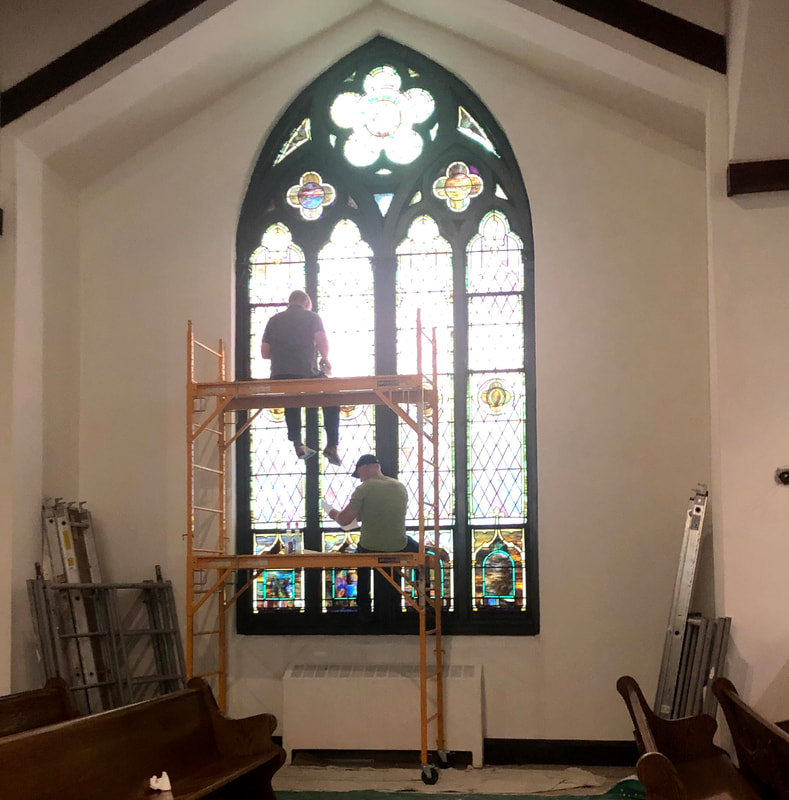 Charles and Rick divide and conquer.
Charles and Rick divide and conquer.
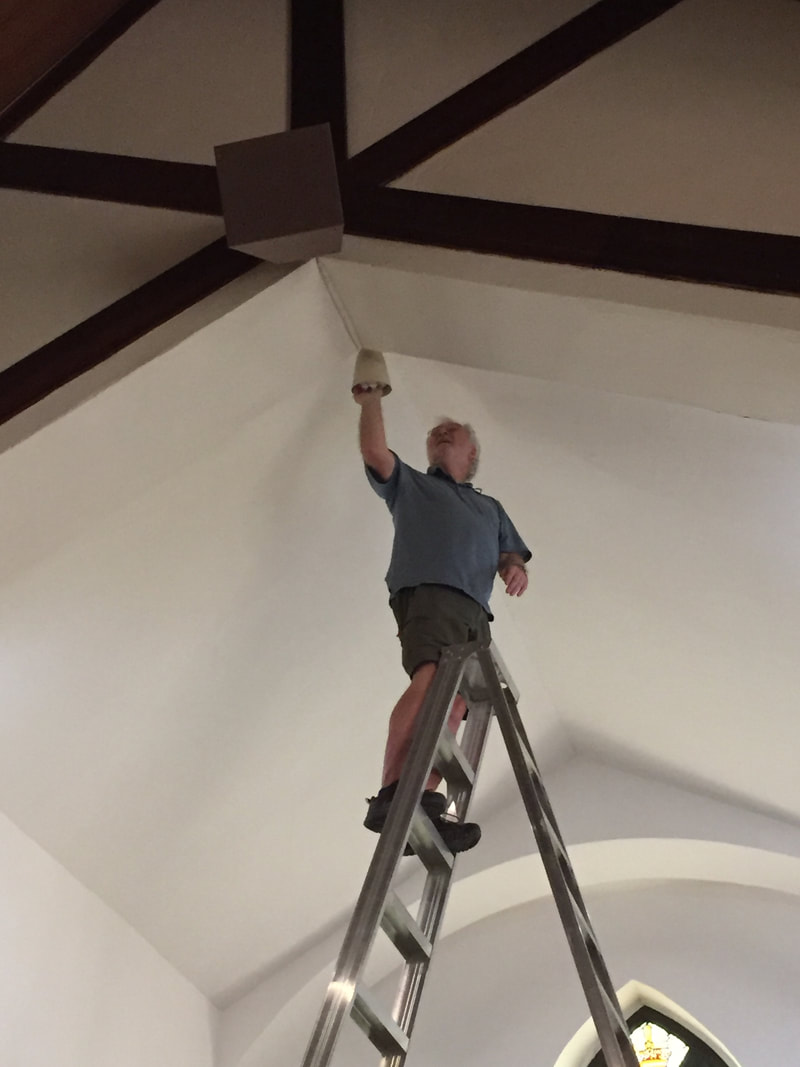 John is syncing all the light bulbs to the same color, so the newly painted walls look terrific.
John is syncing all the light bulbs to the same color, so the newly painted walls look terrific.
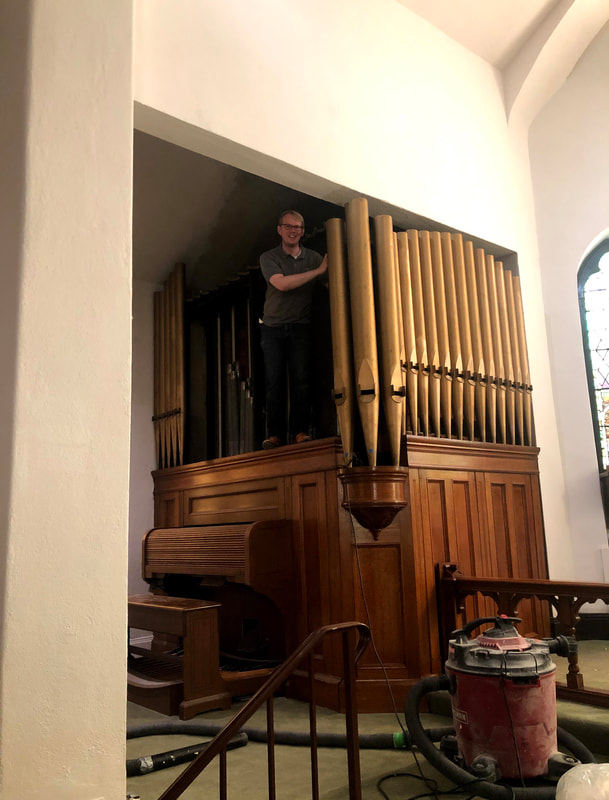 Charles is cleaning the top of the old Möller organ.
Charles is cleaning the top of the old Möller organ.
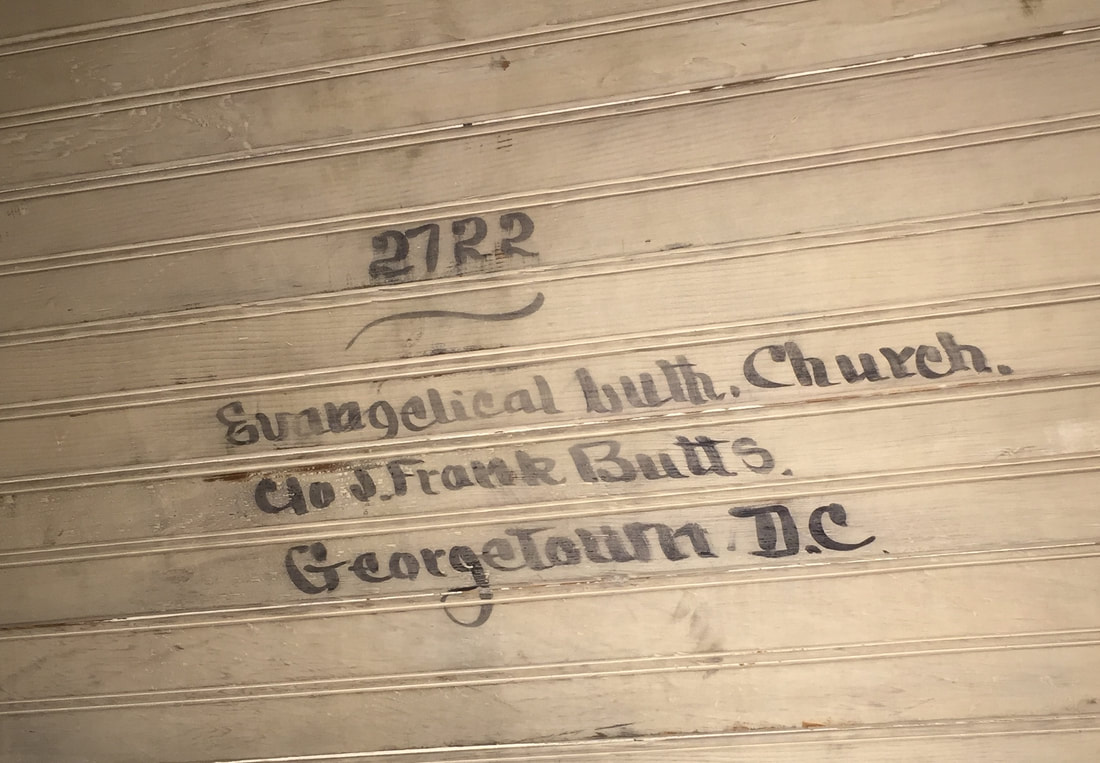 The original Möller factory marks, inside the organ. It was the company's 2,722nd instrument. J. Frank Butts, GLC's treasurer, took delivery of this organ in 1919.
The original Möller factory marks, inside the organ. It was the company's 2,722nd instrument. J. Frank Butts, GLC's treasurer, took delivery of this organ in 1919.
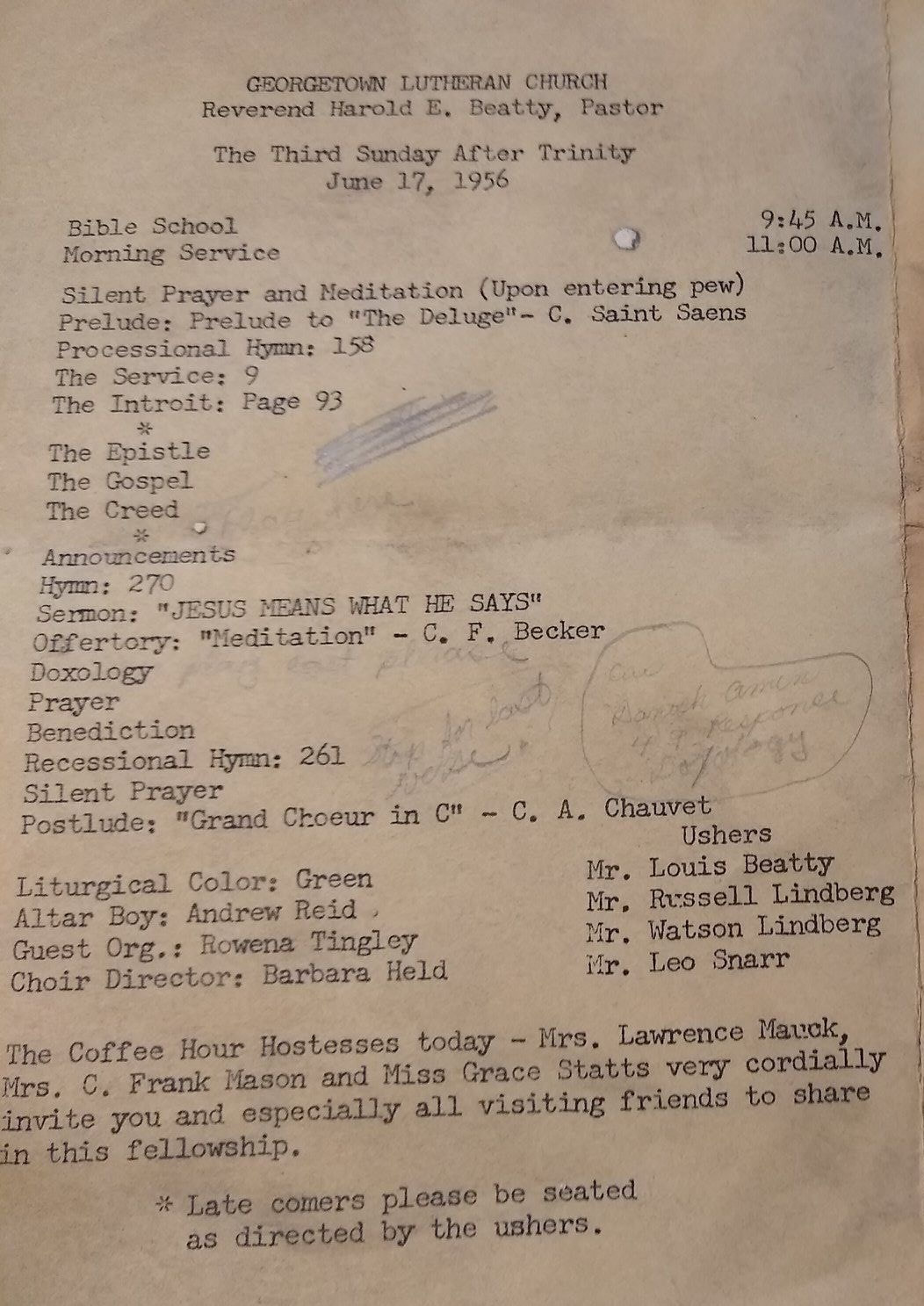 Also found in the old organ: this worship bulletin from 1956, with hand-written notes from the organist. "Stop for last verse." Coffee hour would have been held in the basement, since the fellowship hall was not yet built.
Also found in the old organ: this worship bulletin from 1956, with hand-written notes from the organist. "Stop for last verse." Coffee hour would have been held in the basement, since the fellowship hall was not yet built.
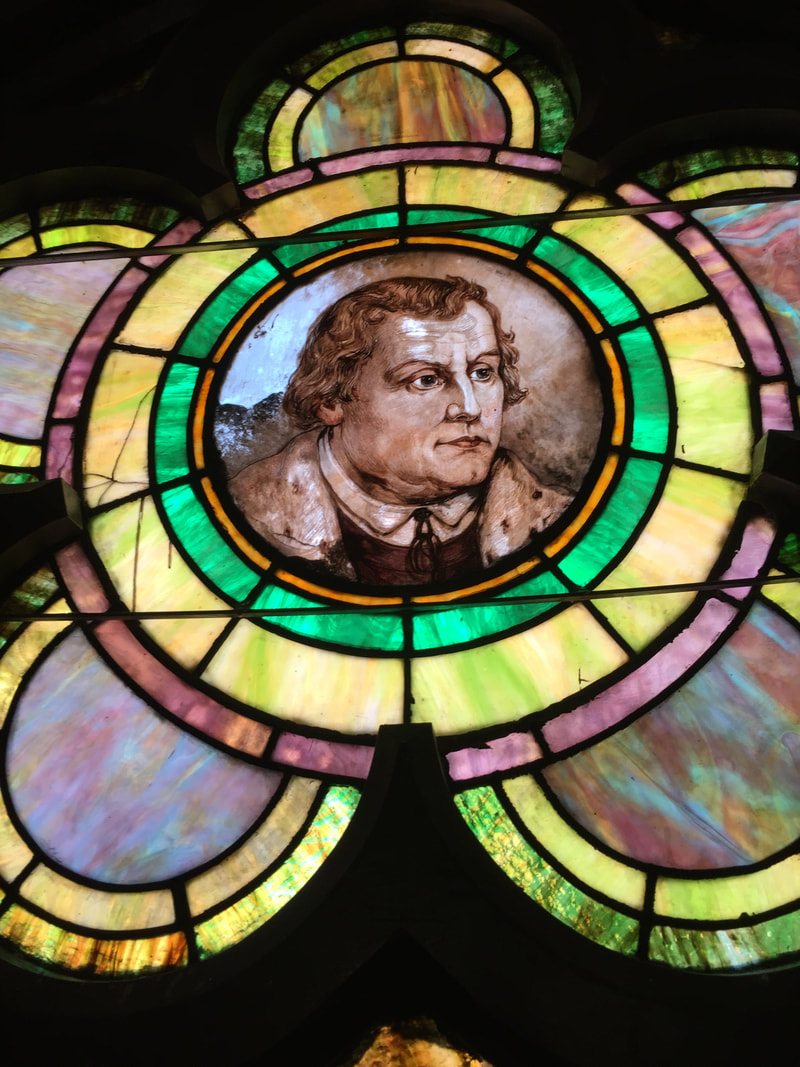
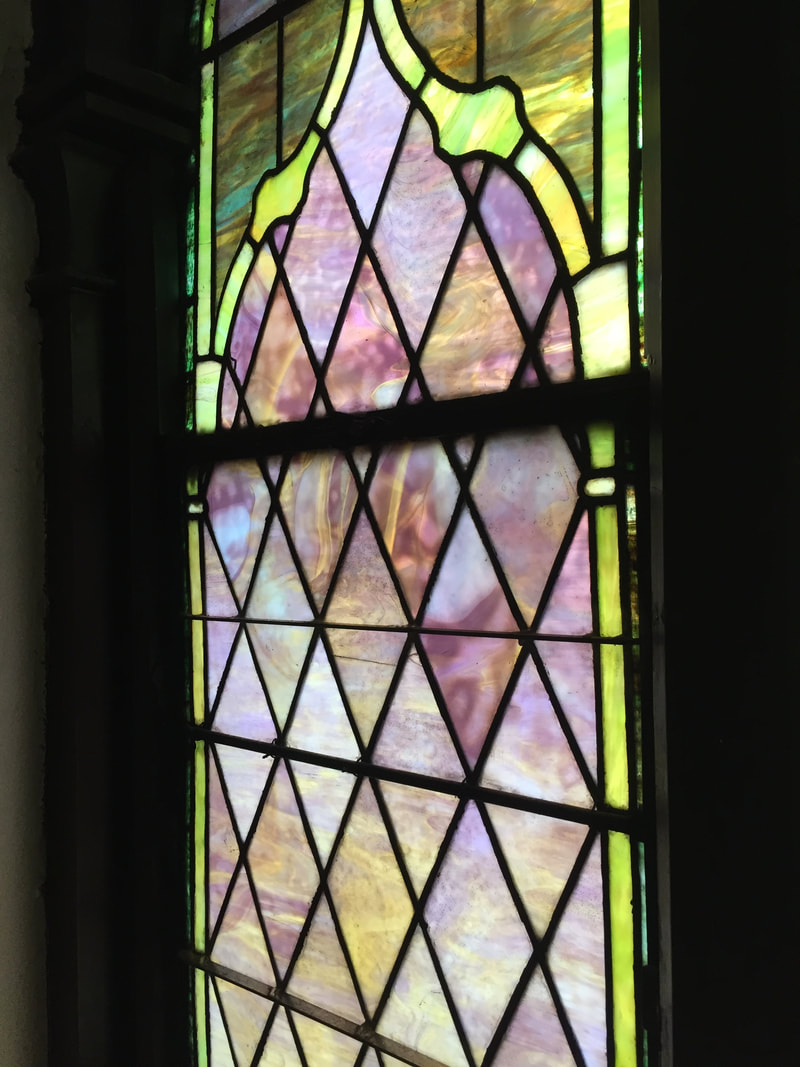
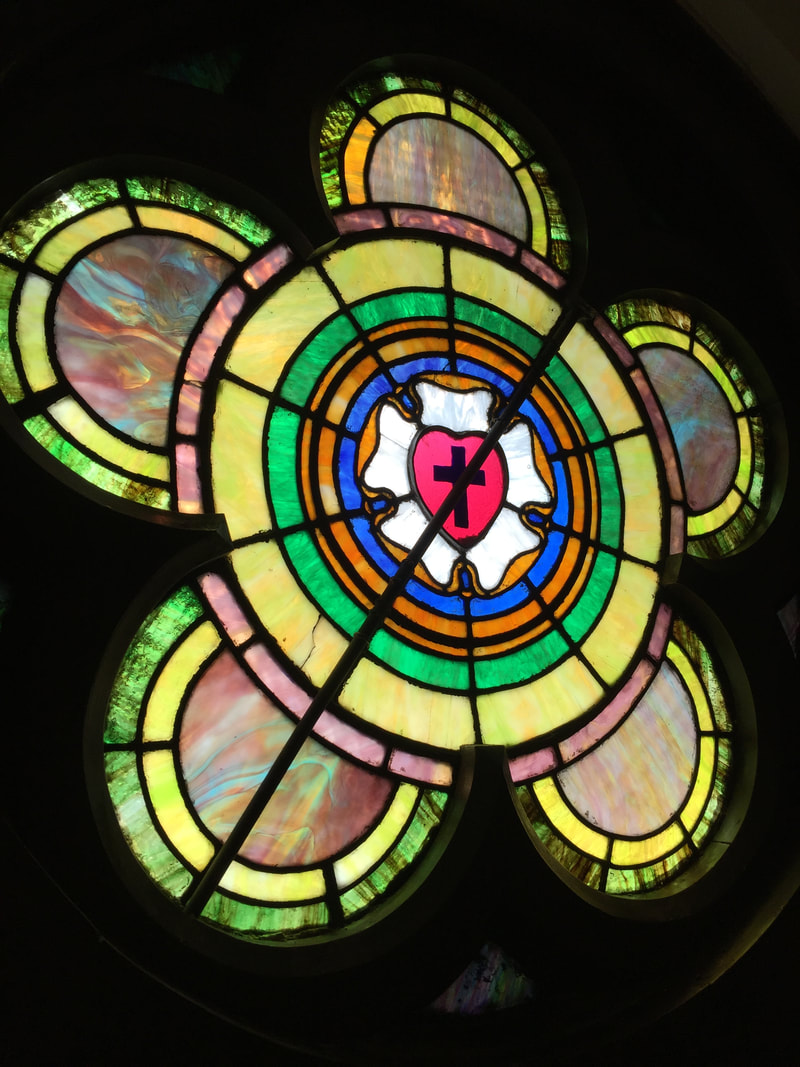
Most of the plaster work is now complete, and we're painting all of the walls (and ceilings) in the sanctuary. Making progress! Look at the beautiful, smooth walls around the altar.
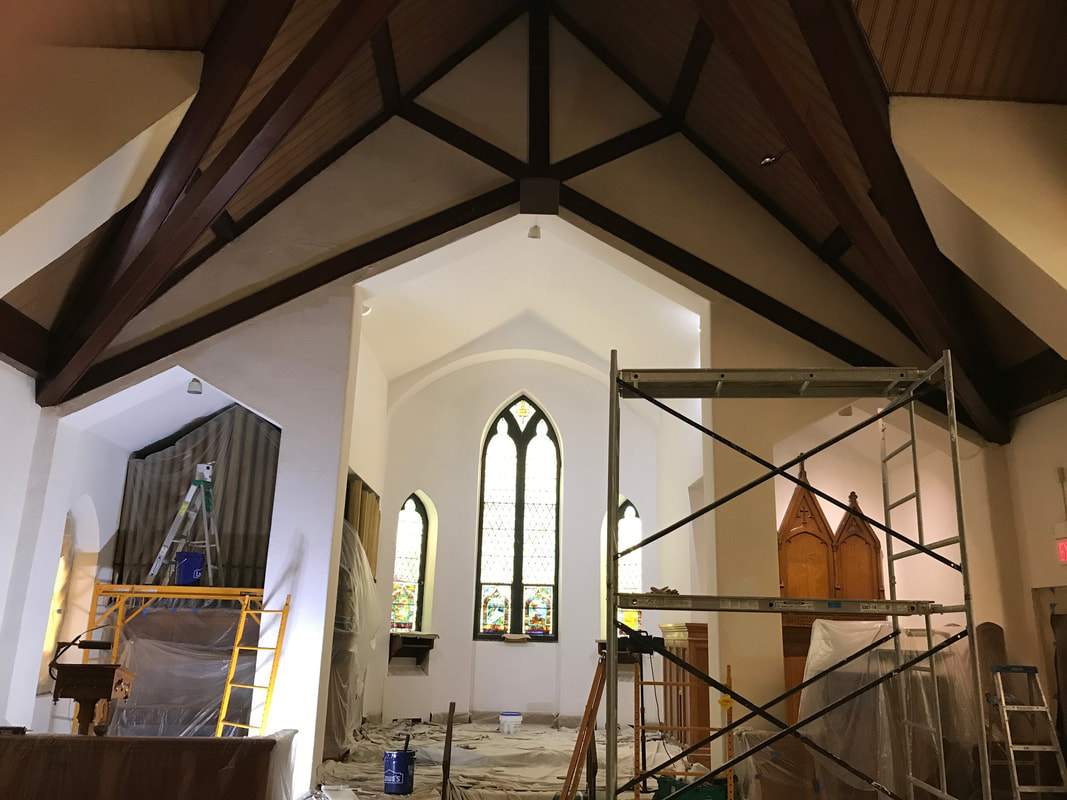
The walls around the altar are completed. Notice that the chandelier sconce hole is gone! They're still painting the high sections of the walls.
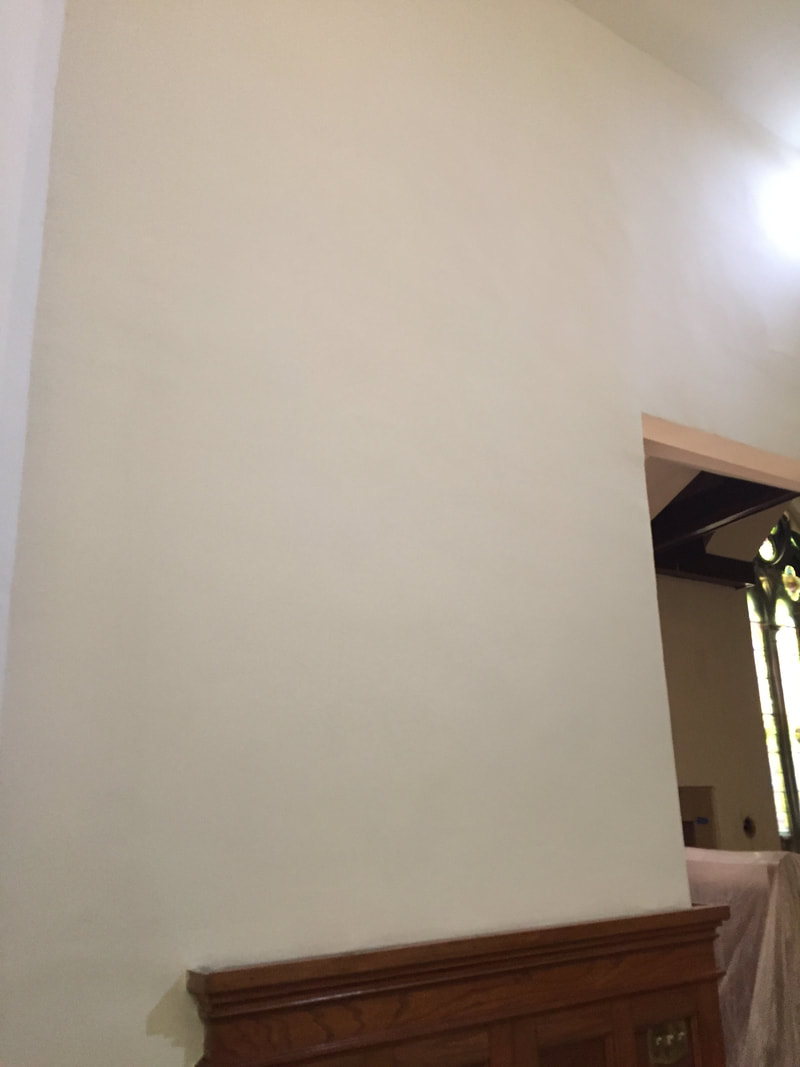
Smooth plaster on the walls around the altar.
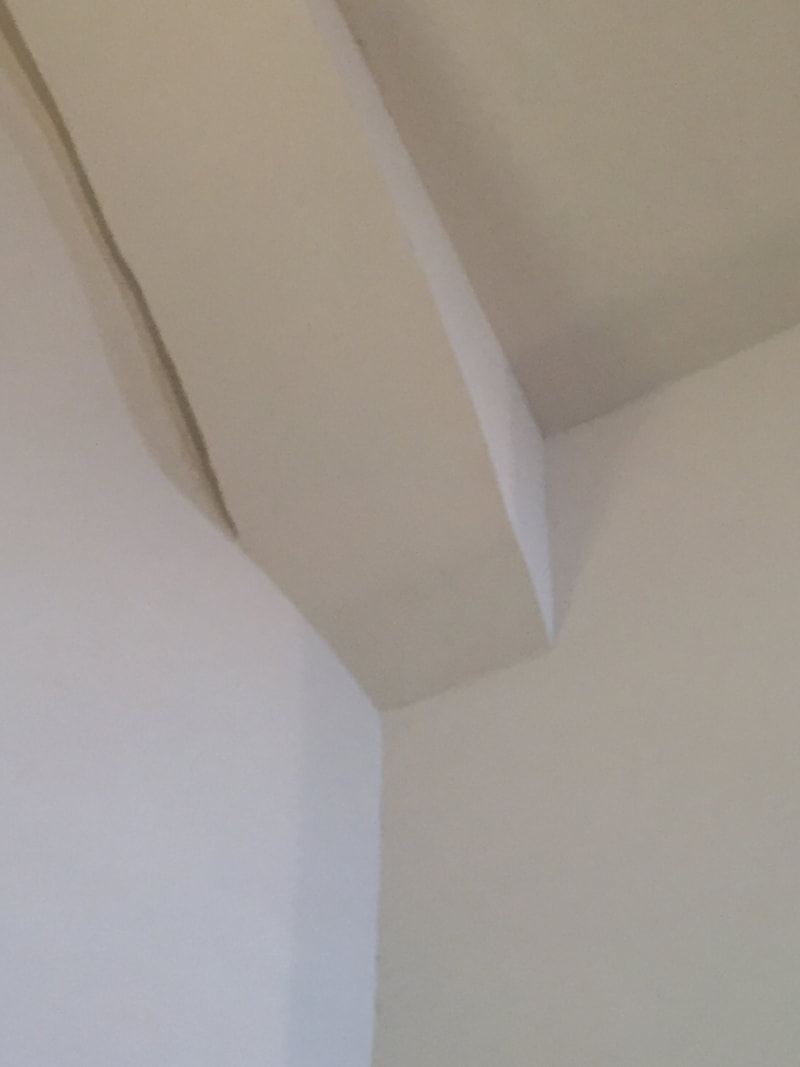
The corners of the archway above the altar, where the worst damage was seen, have been completely restored.
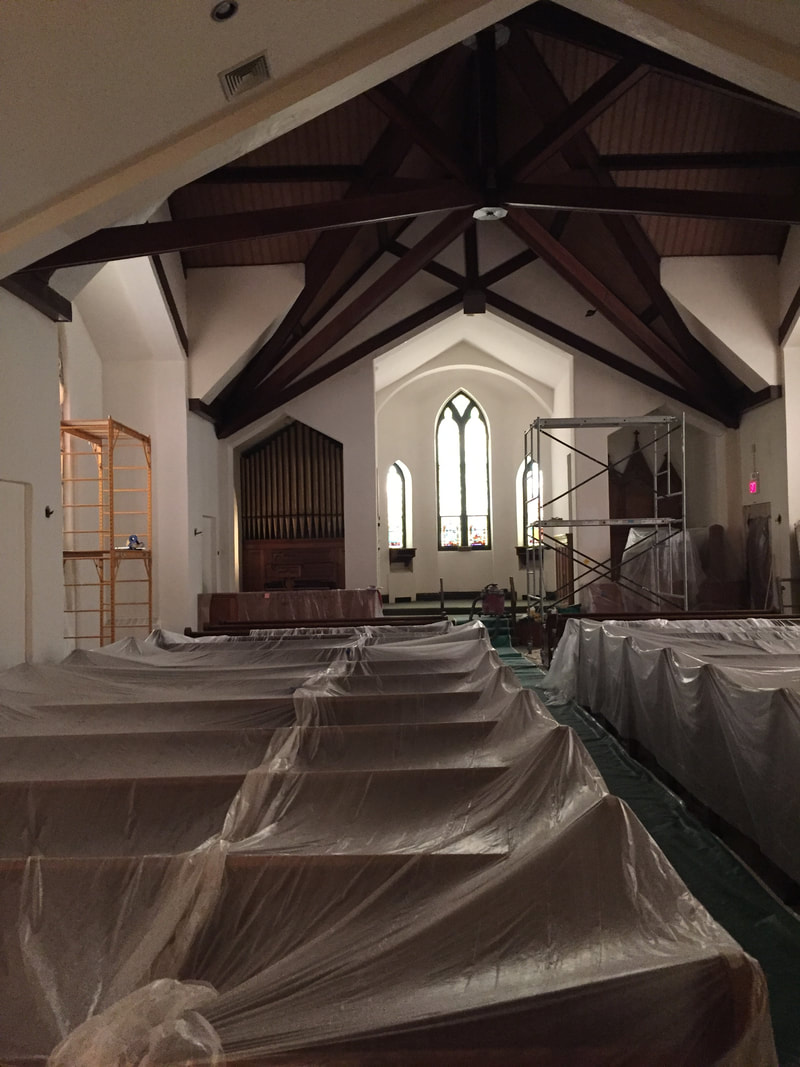
Extensive work went into wrapping the pews and organ to protect them from plaster dust and paint.
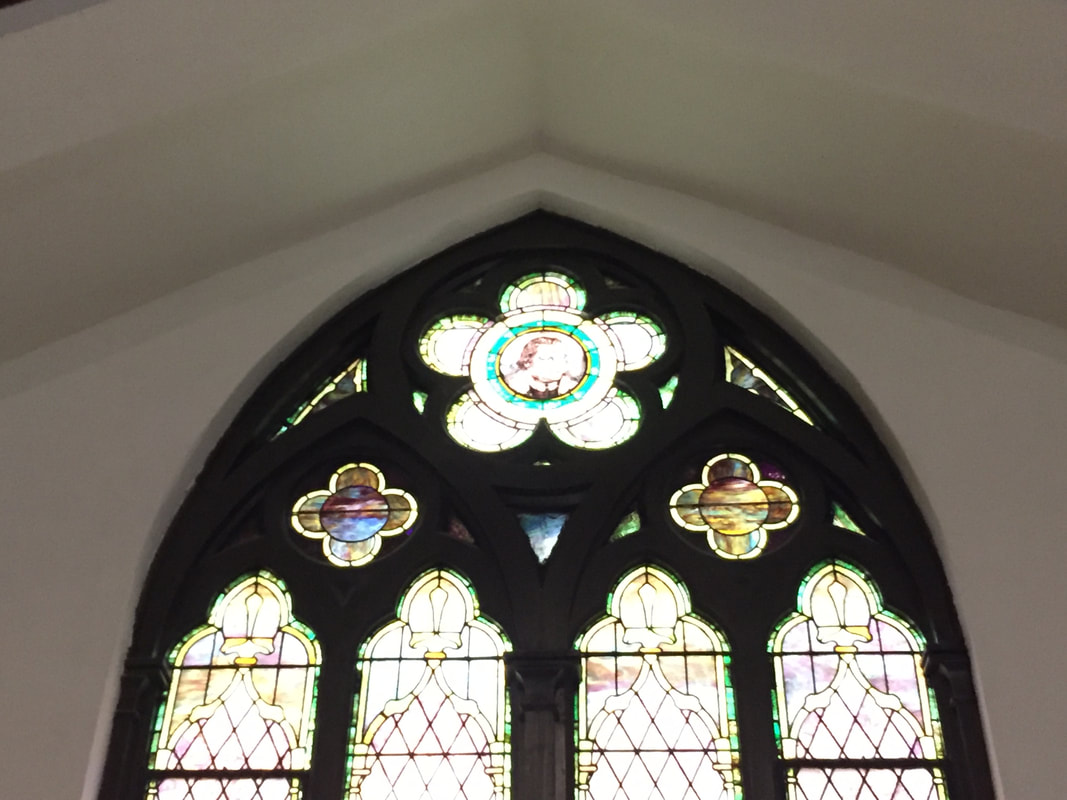
The Martin Luther window is completely restored.
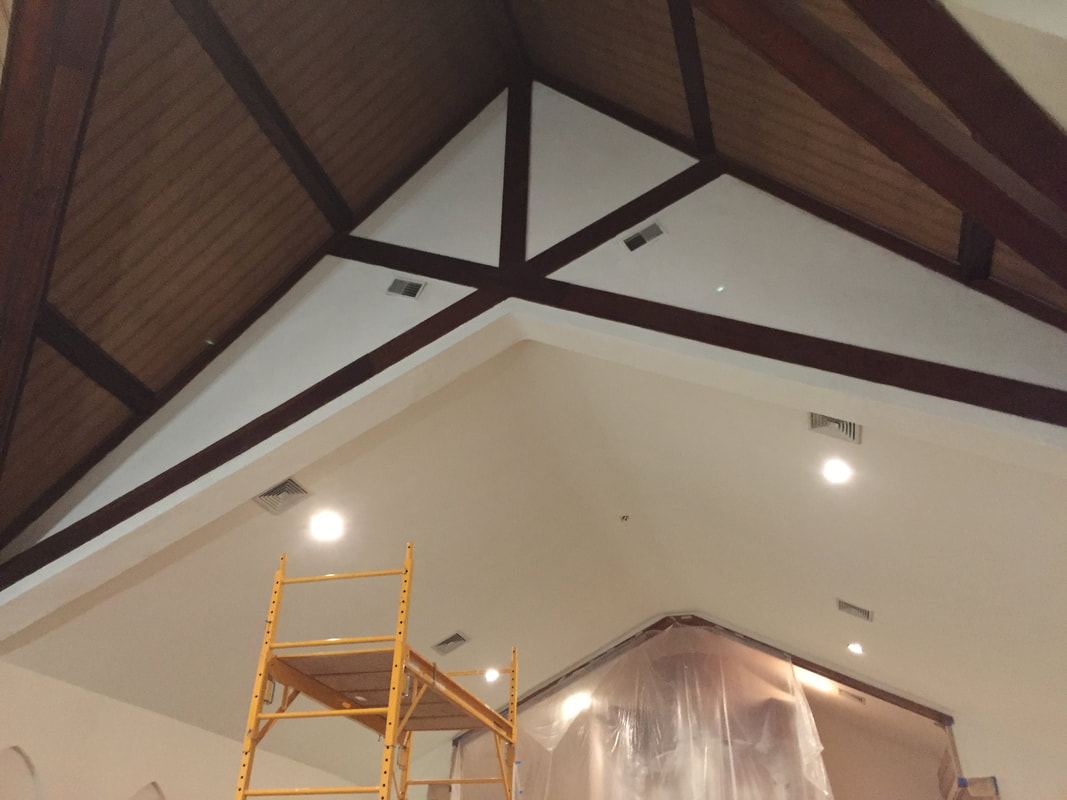
Scaffolding used to reach the highest sections of wall. Note the double-envelope of wrap that is protecting the Howell organ.
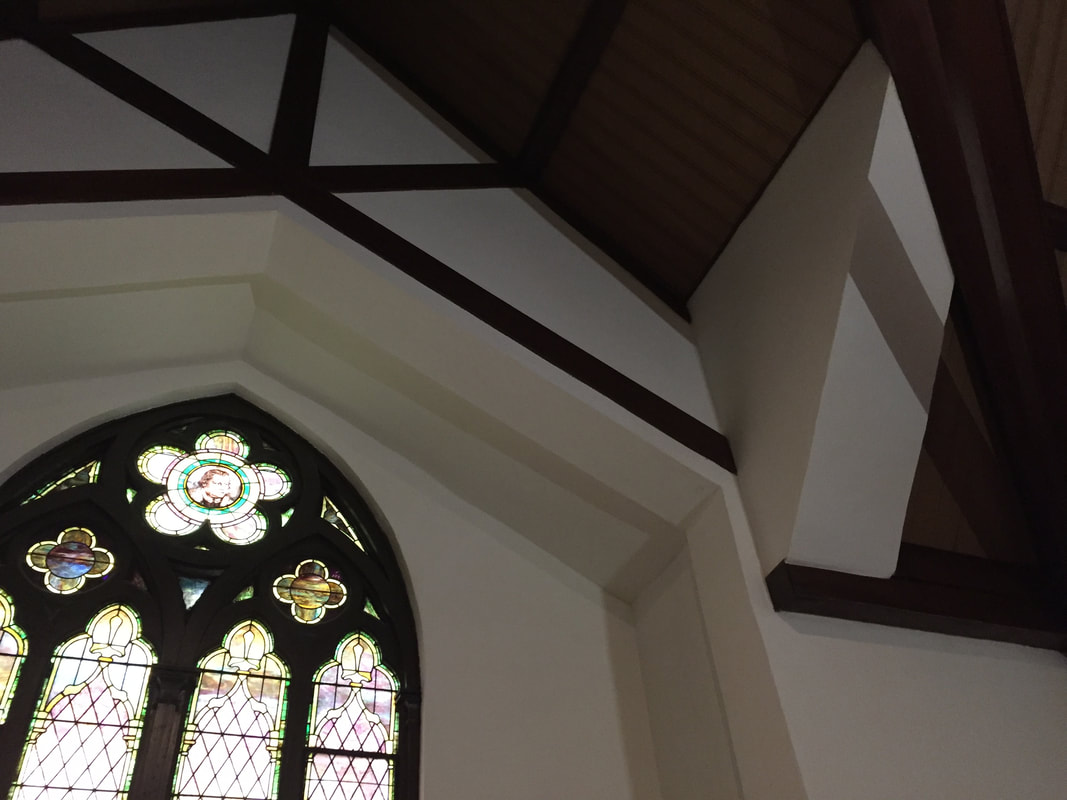
New plaster and paint reflects the light much more brightly.
We are pleased to report that we're making progress on the plaster in the sanctuary. Much of the work above and around the altar is now complete. Our plasterer is turning his attention to the areas above the Luther and Luther Rose windows... meanwhile we're having some unsightly electrical fixtures replaced, and starting to think about paint colors.
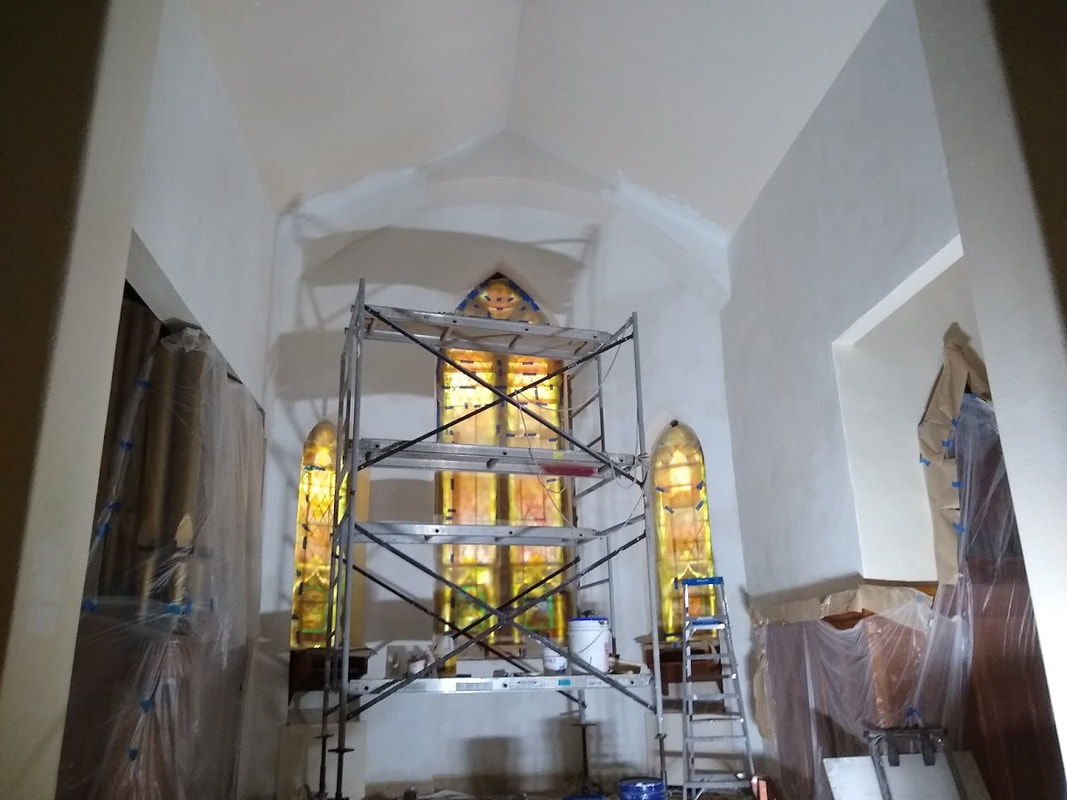
The chancel (above the altar) area is looking great and smooth after significant plaster repairs!
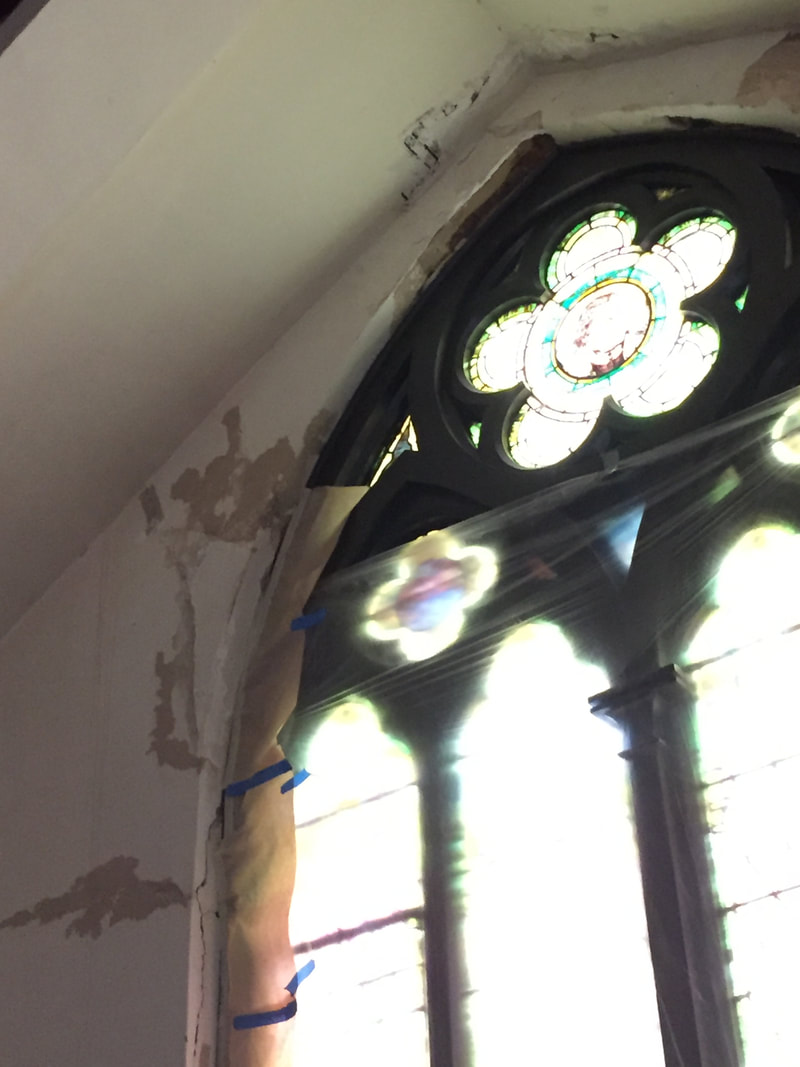
Work in progress above the Luther window - the first steps are important in removing damage and determining extent needed, preparing surfaces...
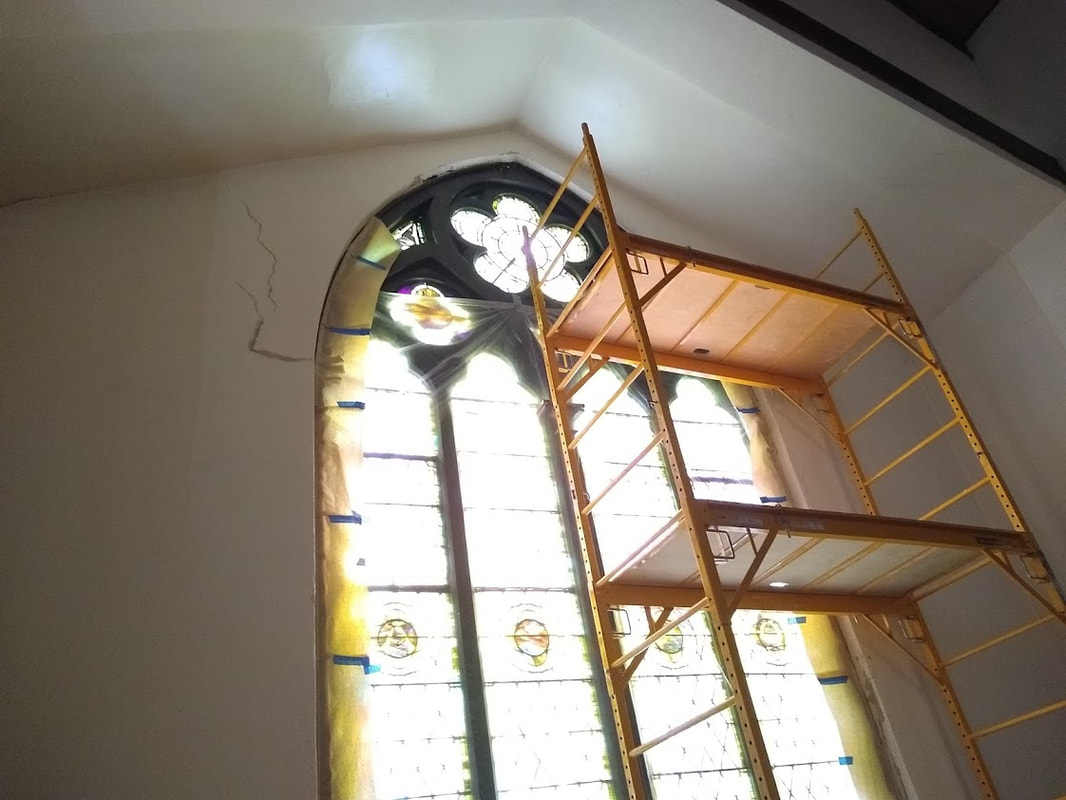 ... and above the Luther rose window.
... and above the Luther rose window.
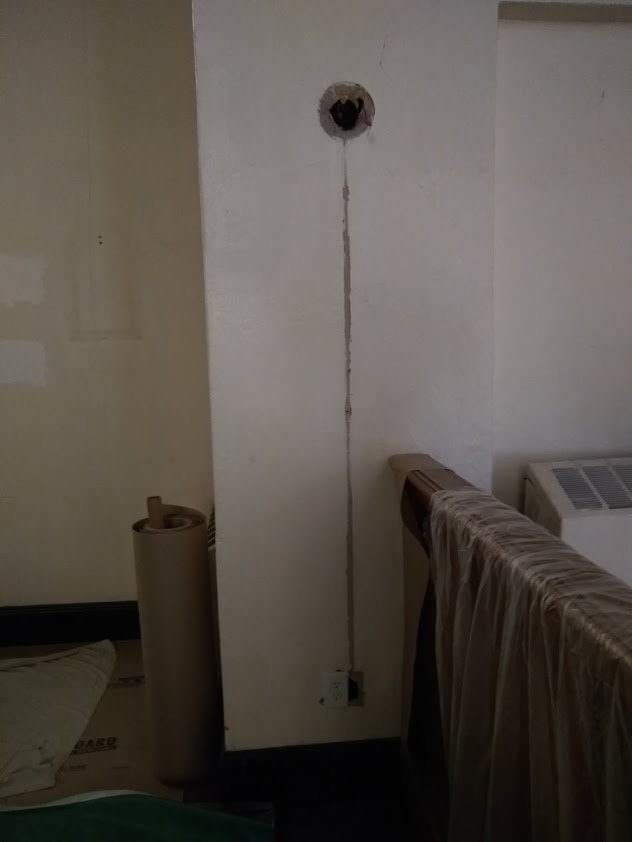 What's this? Where the wall sconces attach, there was an unsightly cable conduit that ran down below each, as well as a protruding electrical outlet. Now all the electrical has been buried behind the wall, and we'll have smooth and beautiful walls below our lights.
What's this? Where the wall sconces attach, there was an unsightly cable conduit that ran down below each, as well as a protruding electrical outlet. Now all the electrical has been buried behind the wall, and we'll have smooth and beautiful walls below our lights.
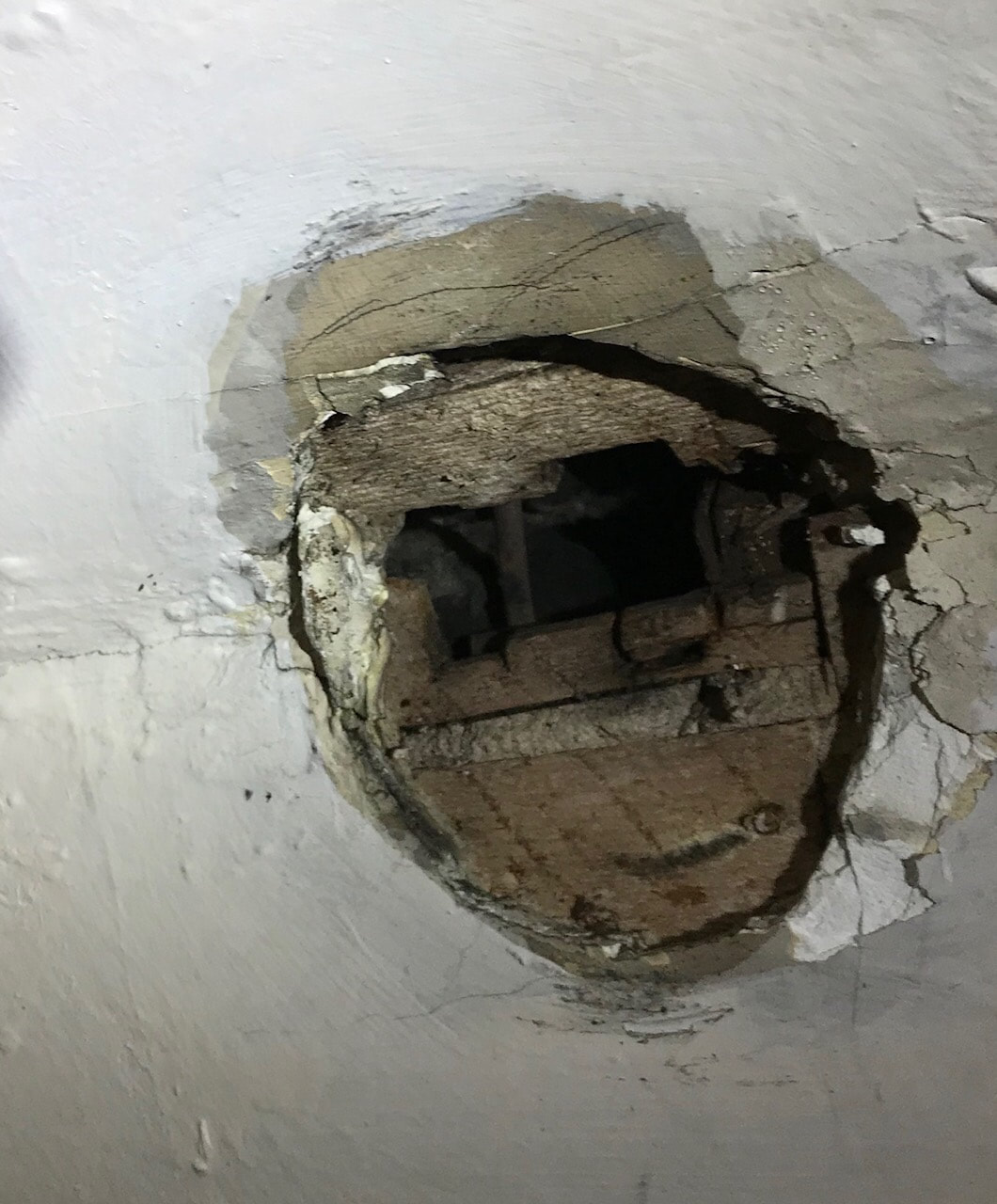 The unused chandelier sconce has been removed from above the altar! Note the pencil markings made by the original builders, and the many old coats of paint. Now to patch up this giant hole...
The unused chandelier sconce has been removed from above the altar! Note the pencil markings made by the original builders, and the many old coats of paint. Now to patch up this giant hole...
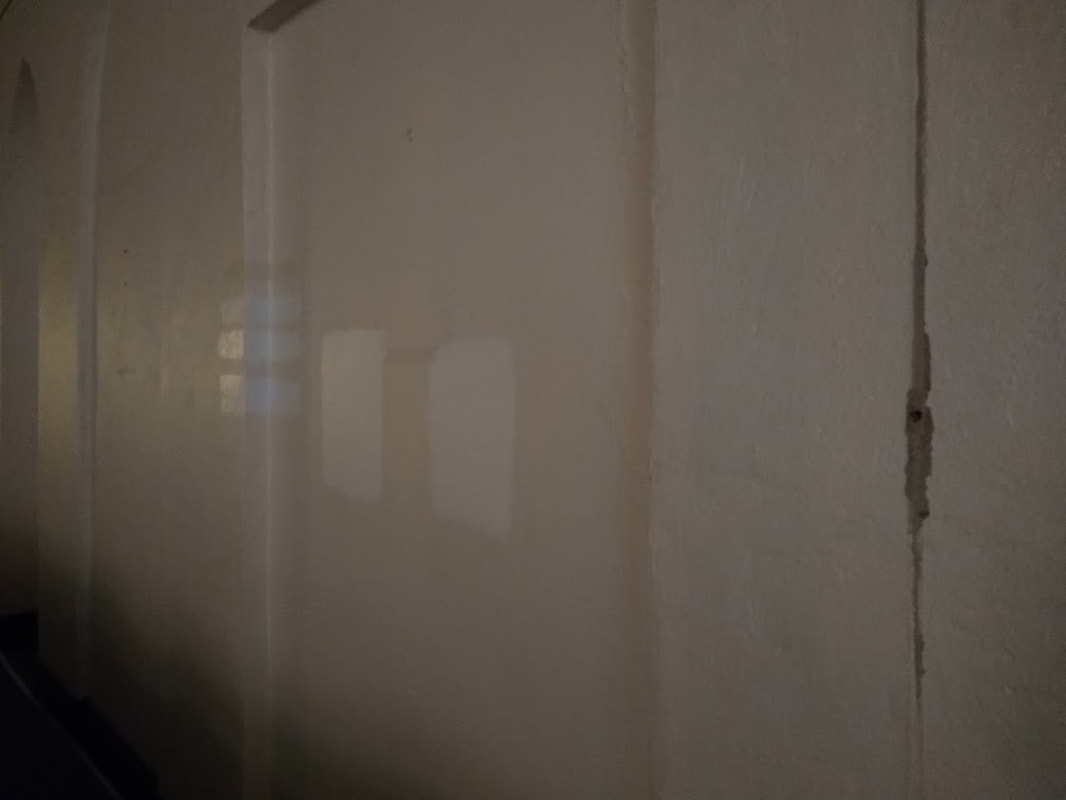
Paint has been chosen! We're excited for the fresh paint that will brighten our sanctuary and freshen our sacred, welcoming space for our anniversary and beyond!
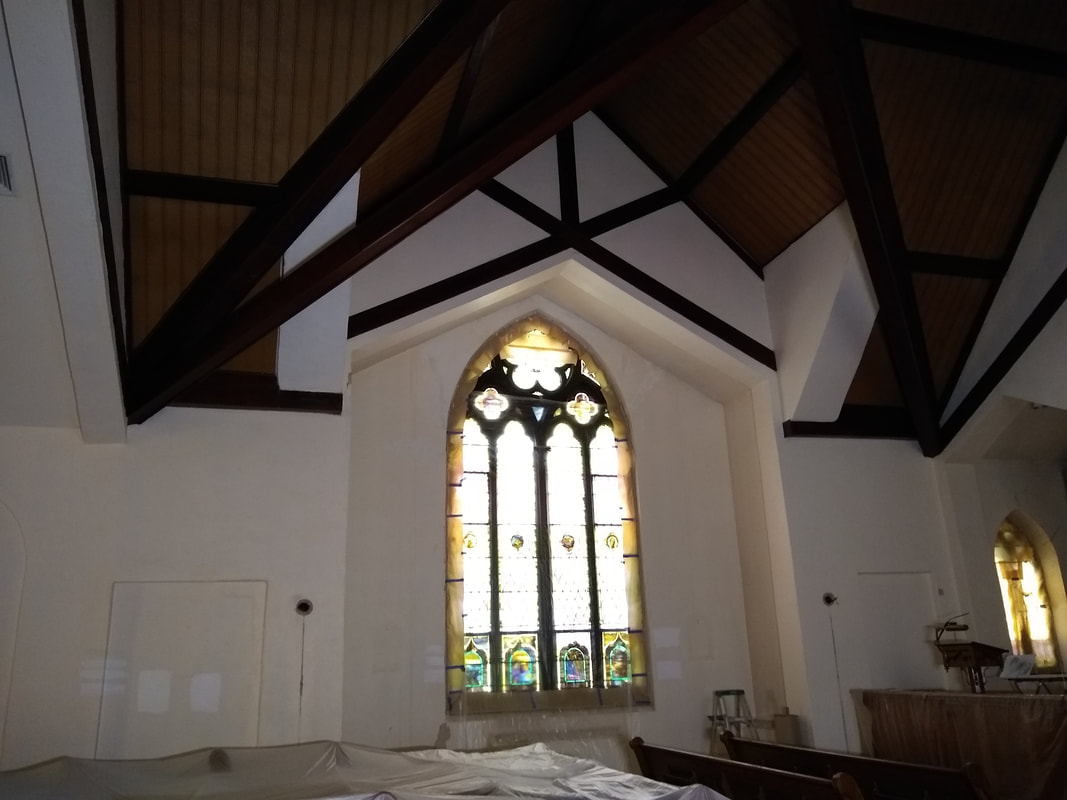
Testing out various paint colors. The consensus was to try something brighter and matte.
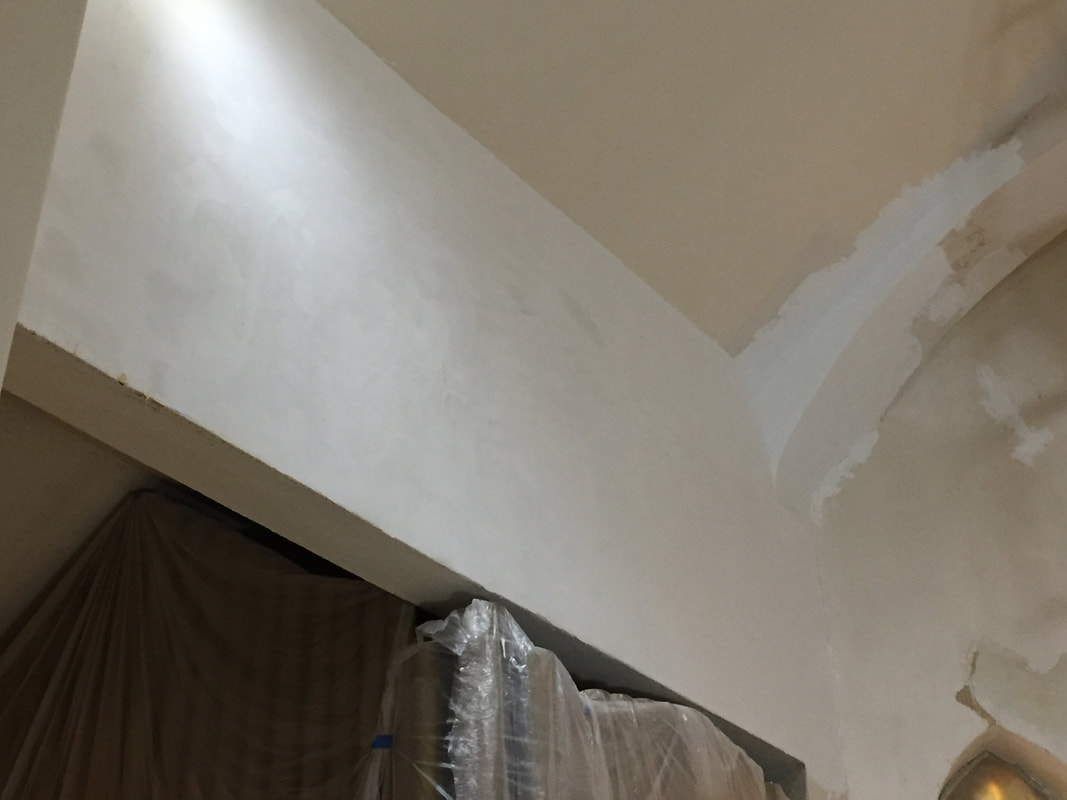 Most of the plaster was removed from the wall behind the altar, and on each side of it. This gave us a chance to change the texture. Because this is the focal point of our worship services, we chose a smooth finish for the plaster here, to help brighten the space.
Most of the plaster was removed from the wall behind the altar, and on each side of it. This gave us a chance to change the texture. Because this is the focal point of our worship services, we chose a smooth finish for the plaster here, to help brighten the space.
Monday, July 15 began the next major step in our Grow-Restore-Serve building projects: plaster repair and repainting in the sanctuary! The damage to the sanctuary interior, most significant over the altar and the two largest stained glass windows on either side, was caused by the roof leaks and damage. Now that the roof work is complete and everything is dry and holding, the plaster work has begun!
Our sanctuary is mostly plaster, not drywall or another (easier) material. It's been repaired and patched in a variety of ways over the years. We're taking the opportunity here to do it right, fix these repairs, and repaint the interior for a fresh, protected space for worship for the decades to come! Our plasterer is a craftsman whose family has done this for generations, and his son is assisting him. The new plaster is smooth and beautiful, and we're shoring up the integrity of much of the existing plaster, so that this work will last.
Worship services have moved into our Fellowship Hall while this work is taking place. The altar and other furniture are currently set up there.
Here are some photos of how the work has evolved over the altar so far:
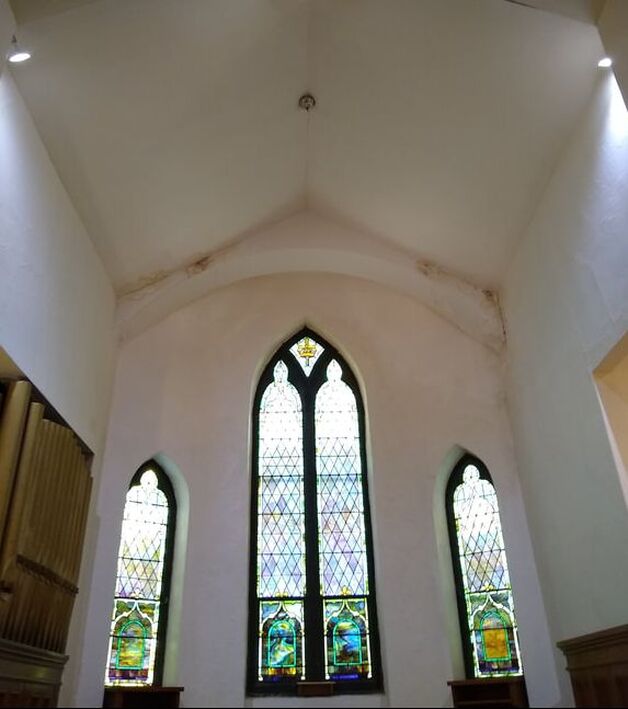 Before work began on July 15. Note the damaged plaster in the corners, and blistering/cracking on the wall on the right side, and the disused chandelier sconce on the ceiling.
Before work began on July 15. Note the damaged plaster in the corners, and blistering/cracking on the wall on the right side, and the disused chandelier sconce on the ceiling.
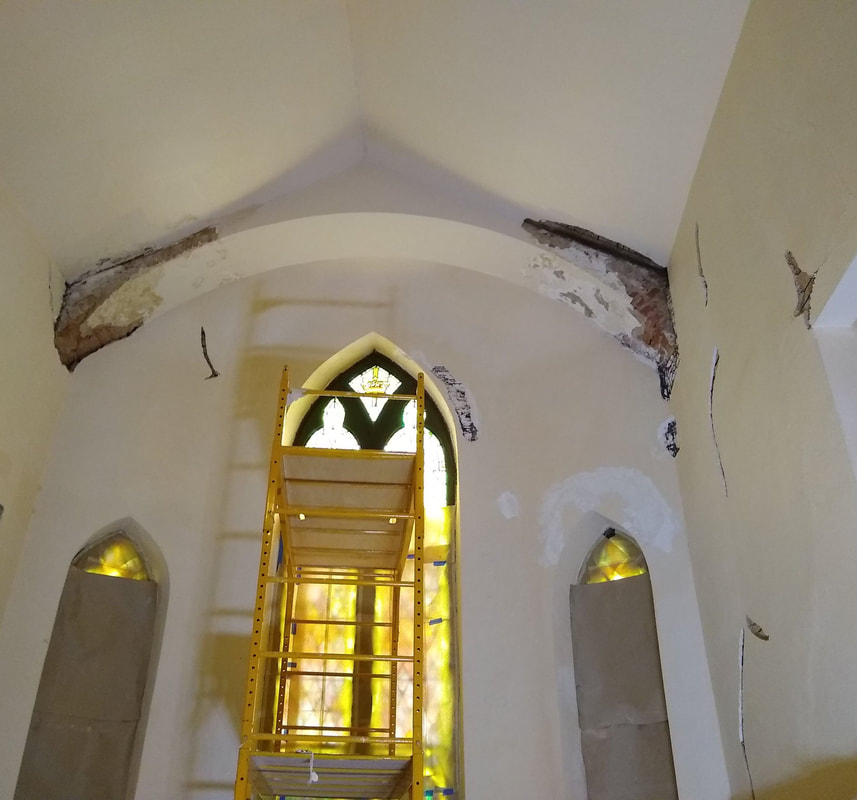 With the damaged plaster removed, the structural red brick of the arch became visible, as well as the original wooden lath and later wire mesh that holds the plaster in place. On the right side, some cracks needed removal and repair.
With the damaged plaster removed, the structural red brick of the arch became visible, as well as the original wooden lath and later wire mesh that holds the plaster in place. On the right side, some cracks needed removal and repair.
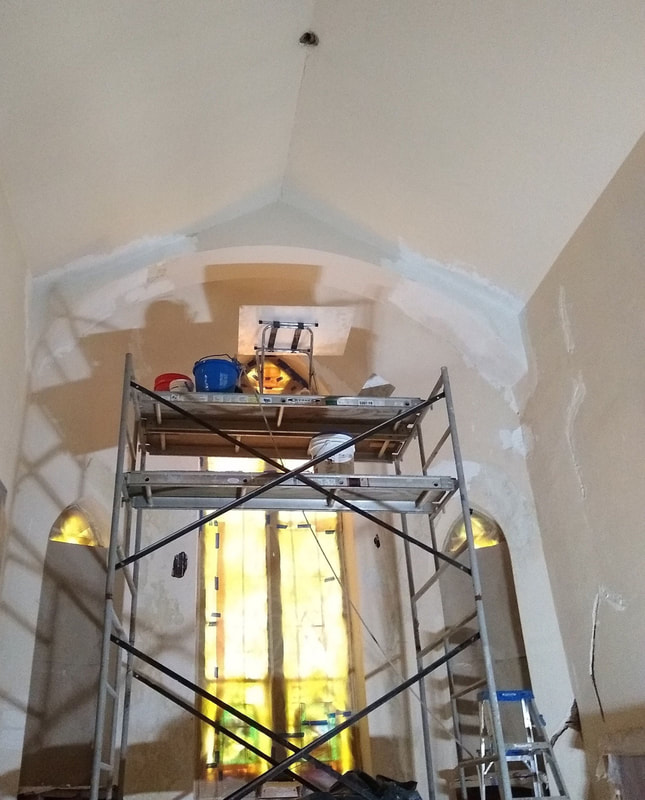 In progress, on July 25. The new plaster is on the arch, and the sconce from the old chandelier (original to the building but no longer used) has been removed.
In progress, on July 25. The new plaster is on the arch, and the sconce from the old chandelier (original to the building but no longer used) has been removed.
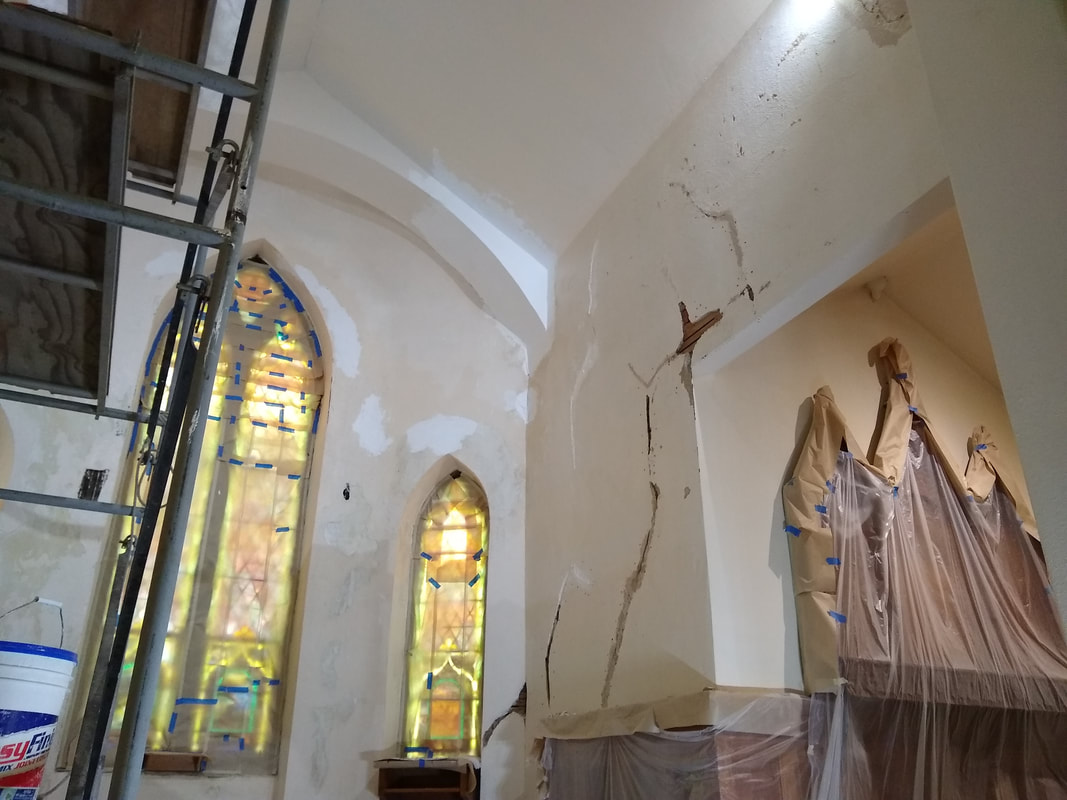 In progress, on July 30. The white areas are new plaster. The cracks are being repaired and, if you look closely, some screws have been used to stabilize areas where the plaster has floated away from the lath behind it.
In progress, on July 30. The white areas are new plaster. The cracks are being repaired and, if you look closely, some screws have been used to stabilize areas where the plaster has floated away from the lath behind it.
We are excited to share that our roof repairs are now complete! Many thanks to the Durable Slate company for their quick work! The needed roof repair was divided into two phases in order to manage cost. Because any time delay could worsen the deterioration of the plaster inside, your council leaders decided to start as soon as possible, utilizing existing capital funds.
Phase 1 work began on April 22, and wrapped on May 8, and cost a total of $34,850, slightly above the estimate, due to needed repair of the wooden decking underneath the tiles (pictured below). We knew there would be some likely surprises and further work needed, and so we built in an adequate cushion in planning for the roof repair.
Phase 2 work began May 22, to address the areas above the Luther and Luther Rose windows, as well as at the back of the sanctuary above the organ and choir. The area by the choir has had some noticeable leaking in recent rains, so we were eager to have this repaired and sealed. Roof repairs were completed on June 14, at a total cost of $62,877.
Roof work may not be the most exciting, but it's really important! Keeping our sanctuary protected and caring for our building is important stewardship. Plus, it happens to be beautiful - check out the glint of copper in our restored flashing and the tiles that crown our building!
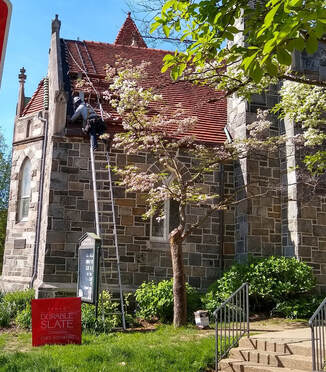 Work began on the slanted sanctuary roof
Work began on the slanted sanctuary roof
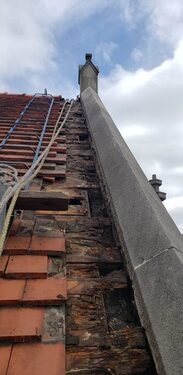 Severe water damage to the wooden decking beneath the roof tiles required some additional work on the bell tower side of the sanctuary roof.
Severe water damage to the wooden decking beneath the roof tiles required some additional work on the bell tower side of the sanctuary roof.
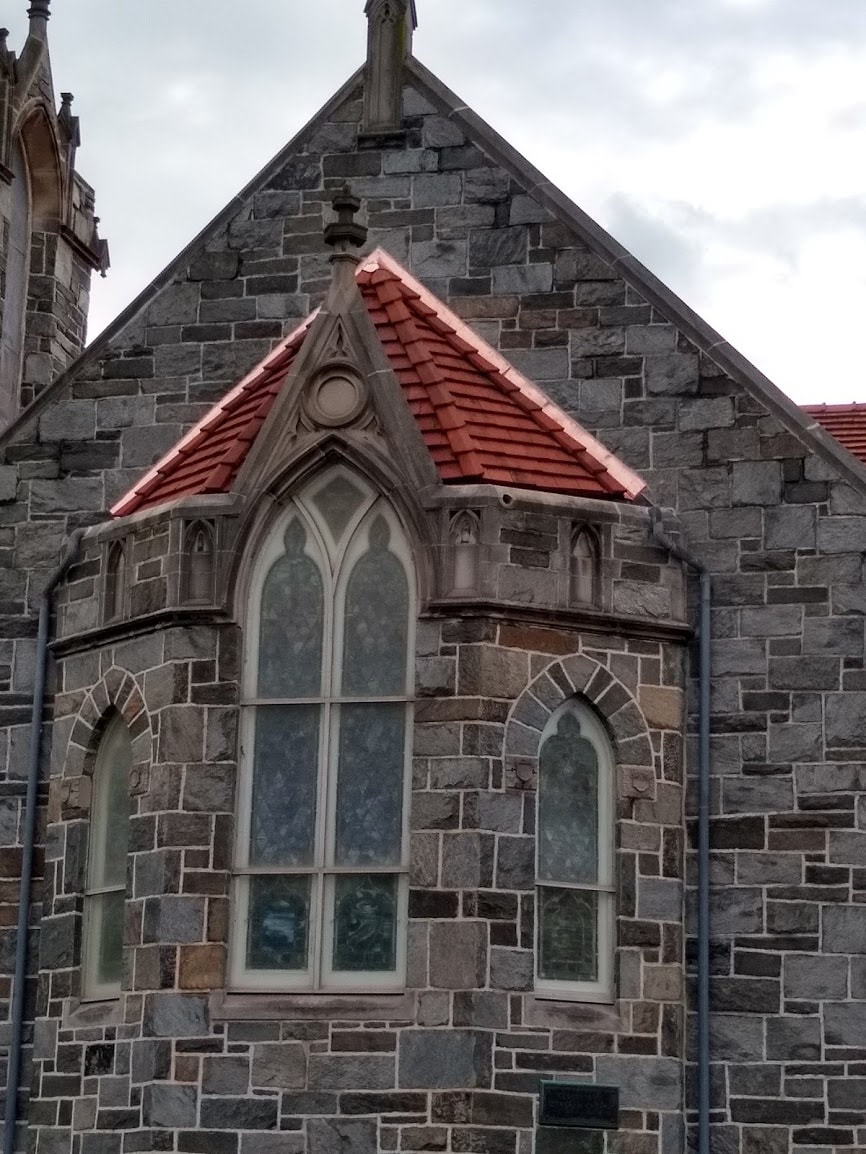
Completed work on the smaller altar roof
On Monday, April 22, the Durable Slate company began repairing the severely-damaged roof joints above our sanctuary. After reviewing bids from 6 vendors, your GLC council selected Durable Slate as both the most-qualified and most cost-effective bid to perform this work.
In particular, GLC's property team was impressed with the efforts of Durable Slate to locate and purchase a supply of reclaimed Sharp's Wedge tiles, 7" x 14", which were used in our original construction, but have not been manufactured for 50+ years. With these tiles in-hand, the new roof will accurately reflect our building's original character.
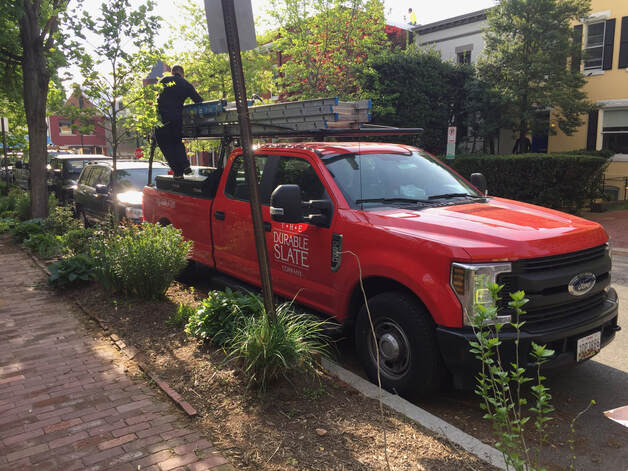 Durable Slate arrives for roof repairs
Durable Slate arrives for roof repairs
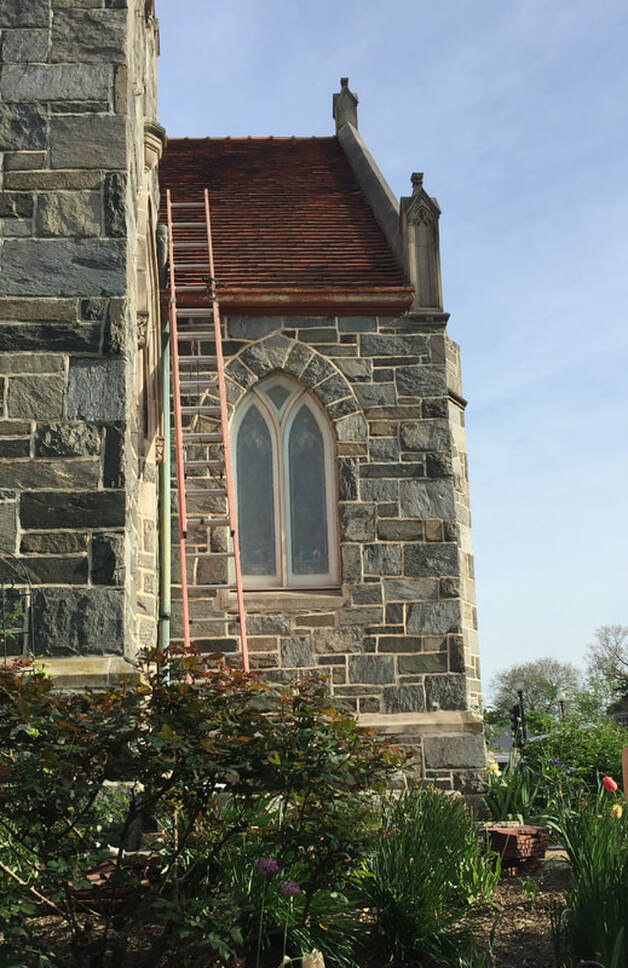 Setting up ladders above the altar, to repair the most severe damage first
Setting up ladders above the altar, to repair the most severe damage first
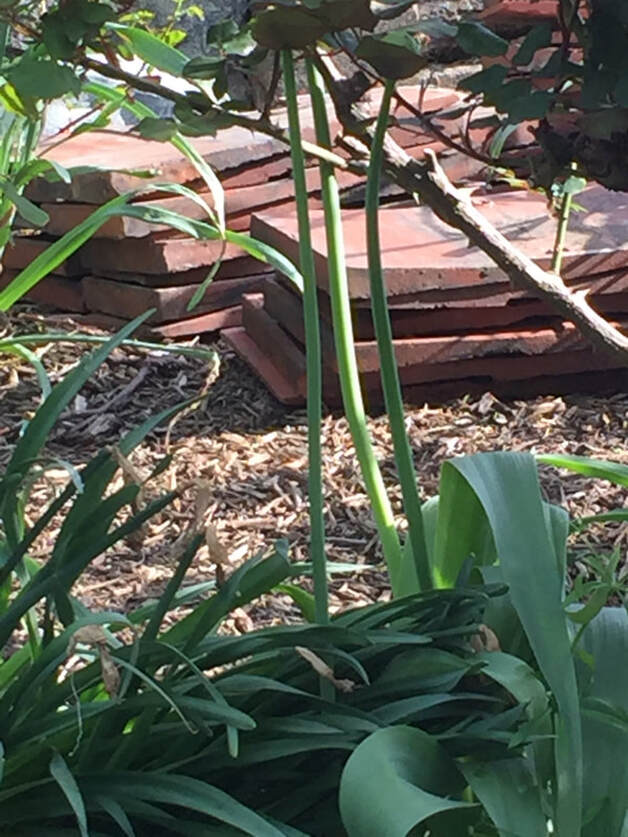 Springtime 2019 at GLC: abundant tulips and reclaimed Sharp's Wedge 7" x 14" tile...
Springtime 2019 at GLC: abundant tulips and reclaimed Sharp's Wedge 7" x 14" tile...
The Georgetown Lutheran congregation met this past Sunday, April 14, to discuss the need for building repairs and longer-term improvements. GLC's council leaders titled this proposal "A Bold 250," because it includes a few different goals. Together, we can achieve these goals in this congregation's 250th year!
Together, we will:
- Achieve a set of projects that will not only repair our leaky roof and its effects, but seek to improve the site for generations to come.
- Raise funds to cover the full cost of all of our building projects, through a capital campaign titled "Grow - Restore - Serve," and additional outreach to our neighbors and historic preservation grants.
- Redouble our efforts to serve our community. Repairs to our historic building cannot be done at the expense of our outreach and feeding ministries. We commit to achieving 250 service hours together in this milestone year.
Here is a copy of the document that was shared and discussed. All 3 motions were carried unanimously, so here we go!
We've all observed, first-hand, the impact of a leaky roof on the sanctuary below. But what's causing all this? How big are the leaks up there, on the roof?
We are so glad you asked! Your GLC council commissioned several roofing vendors to do an assessment of our leaking roof, and below are some of the most insightful photos they captured. We found a few gaps that are wide-open, and letting water in. But we also found a lot of issues due to the use of incompatible building materials... which cause rust and quicker deterioration.
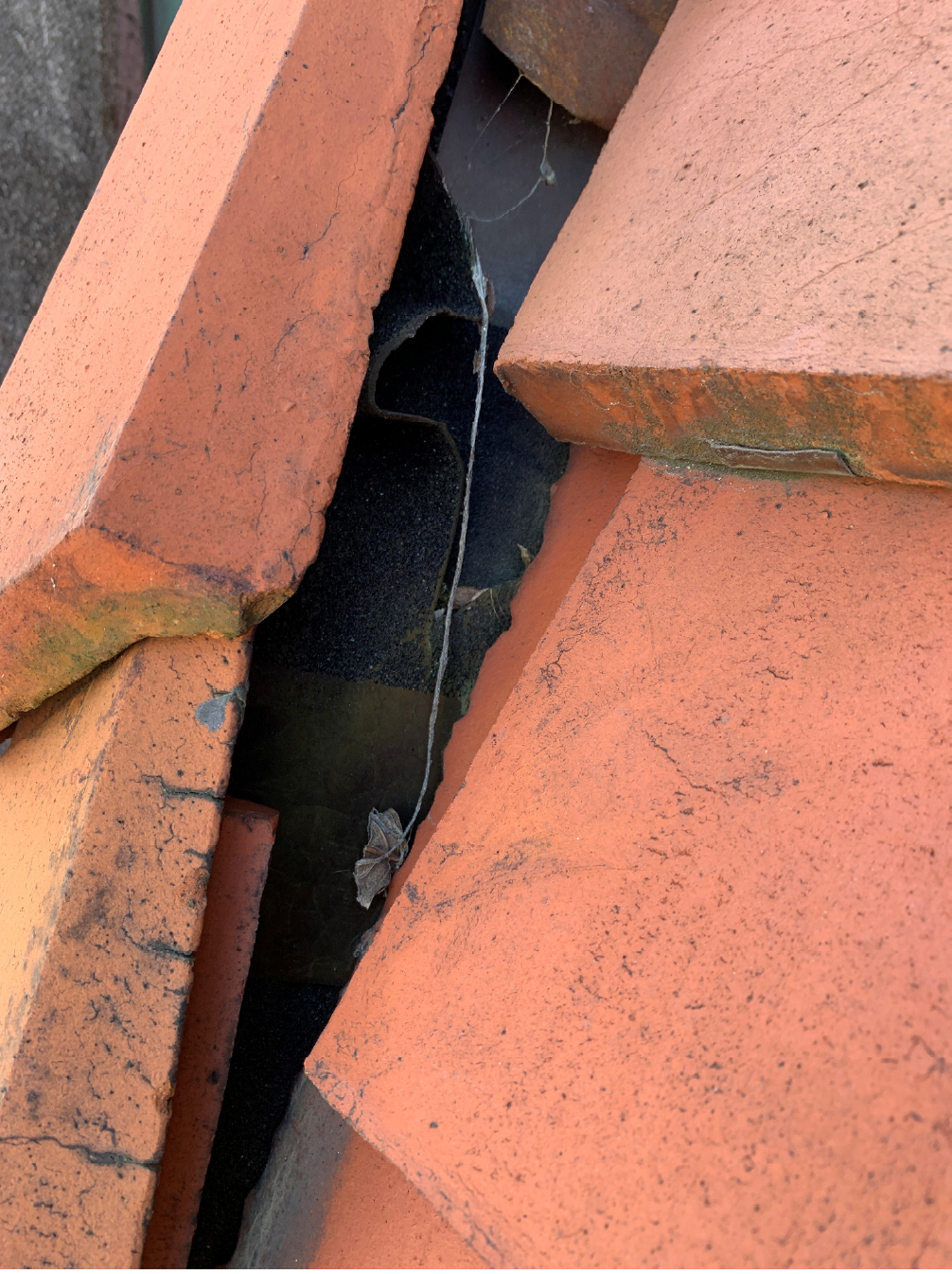 Visible gap between tiles, and a visible rip in the underlying tar-paper, seen on the small roof above the altar. This is definitely letting water in, and may be the principal cause of water damage above the altar.
Visible gap between tiles, and a visible rip in the underlying tar-paper, seen on the small roof above the altar. This is definitely letting water in, and may be the principal cause of water damage above the altar.
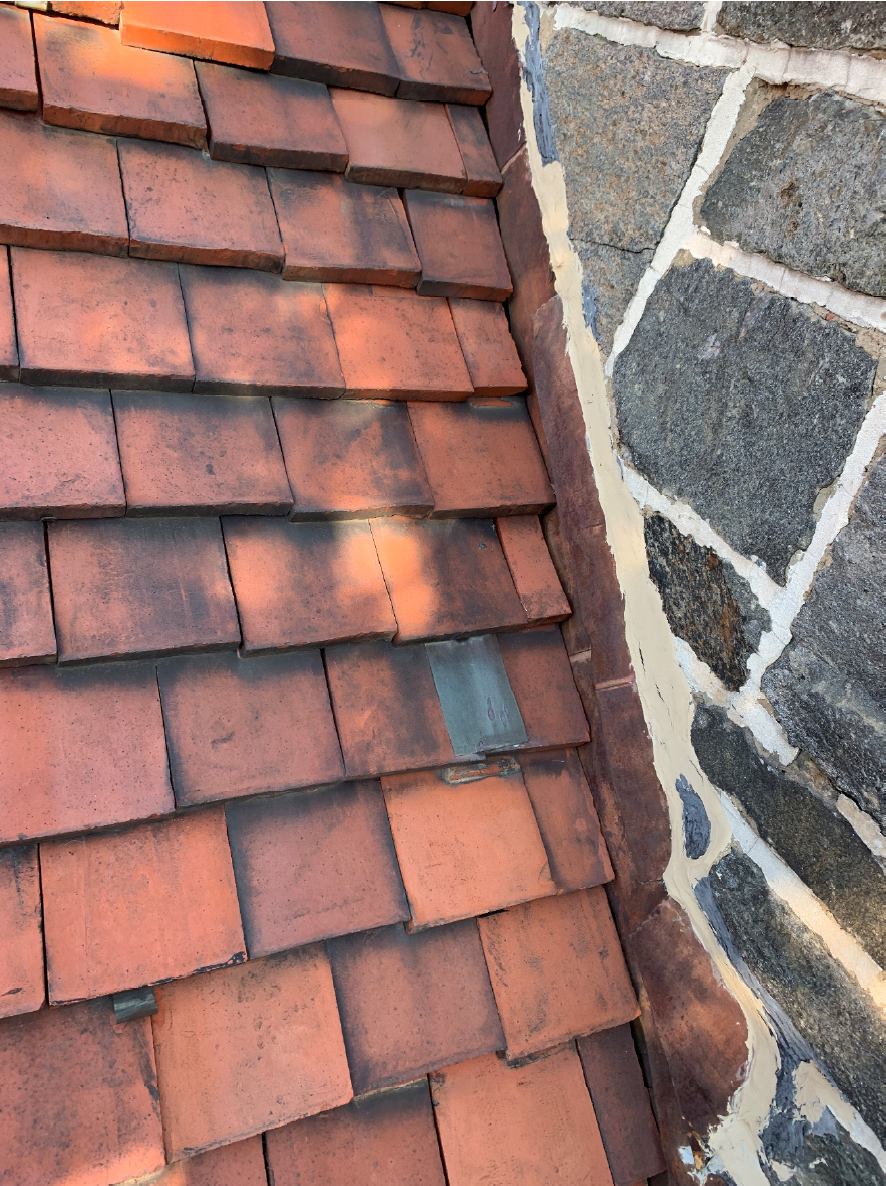 The "flashing" around the edges of the roof is our main concern. The metal sheeting beneath the tiles should curve up the surrounding walls to create a water-tight seal. In this case, we see some corrosion of the flashing, loose tiles, and an awkward repair attempt using caulking. This is above the Luther Seal window, on the south side of the sanctuary.
The "flashing" around the edges of the roof is our main concern. The metal sheeting beneath the tiles should curve up the surrounding walls to create a water-tight seal. In this case, we see some corrosion of the flashing, loose tiles, and an awkward repair attempt using caulking. This is above the Luther Seal window, on the south side of the sanctuary.
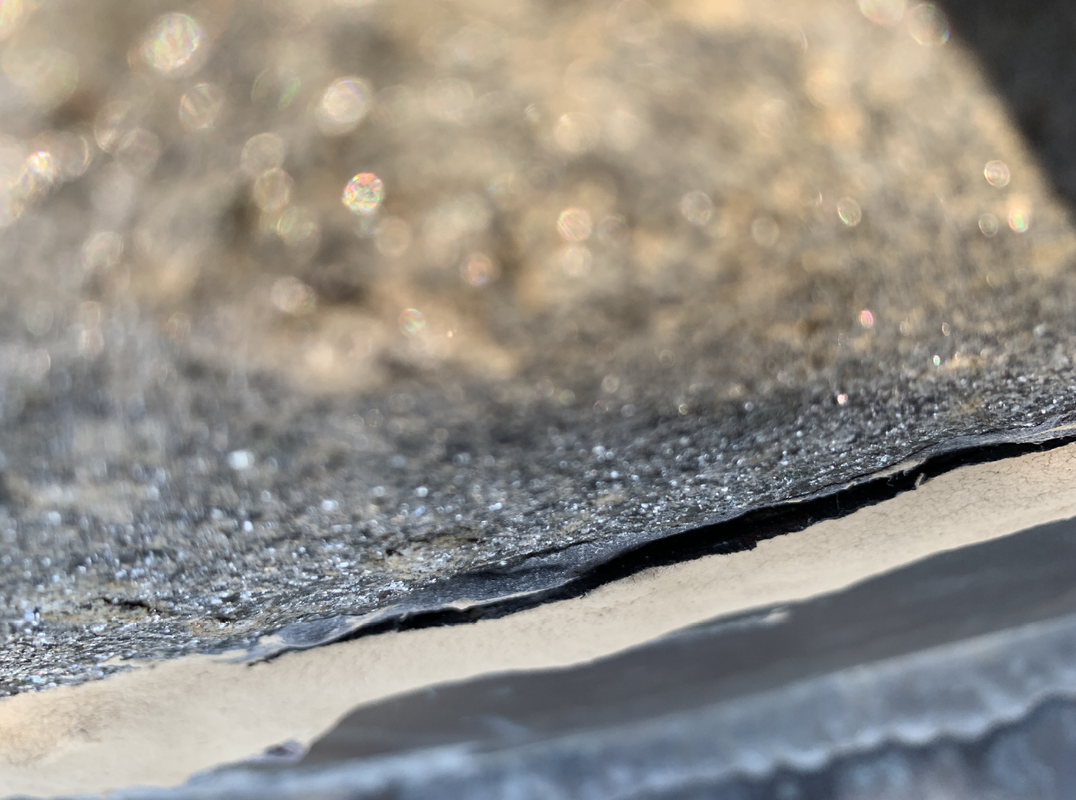 This is a gap in the roof joints directly above the choir and organ. We are seeing a crack in the historic metal flashing, which has been inadequately repaired using caulk. This didn't work -- the metal flashing expands and contracts during the seasons, which the caulk cannot do, and this makes the hole even larger. The correct solution should have been to replace the cracked flashing entirely.
This is a gap in the roof joints directly above the choir and organ. We are seeing a crack in the historic metal flashing, which has been inadequately repaired using caulk. This didn't work -- the metal flashing expands and contracts during the seasons, which the caulk cannot do, and this makes the hole even larger. The correct solution should have been to replace the cracked flashing entirely.
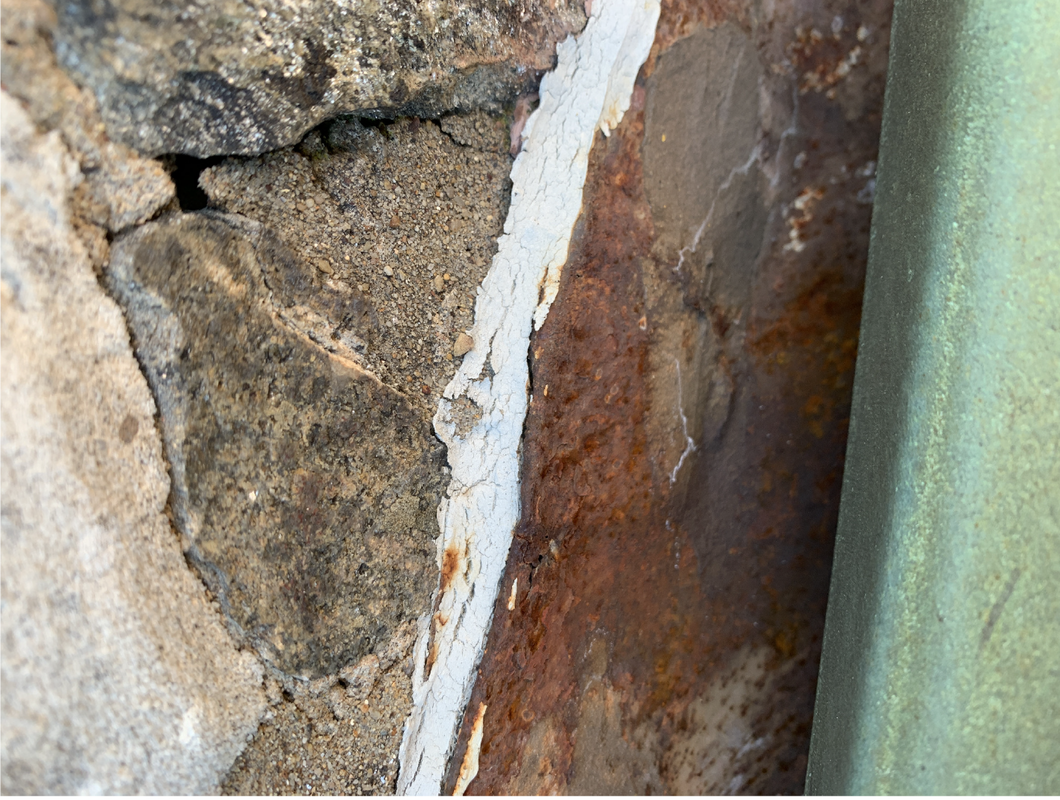 The galvanic reaction: the church's original flashings and gutters are copper, which you see oxidized to a greenish color on the right. In the center, flashings were inexpensively replaced at some point with galvanized steel, which rusts and turns orange. These two elements react in the presence of water, degrading each other. The caulking you see is a temporary fix. The hole on the left probably isn't helping either.
The galvanic reaction: the church's original flashings and gutters are copper, which you see oxidized to a greenish color on the right. In the center, flashings were inexpensively replaced at some point with galvanized steel, which rusts and turns orange. These two elements react in the presence of water, degrading each other. The caulking you see is a temporary fix. The hole on the left probably isn't helping either.
Although your council leaders have been aware of some issues with the plaster in the sanctuary for some time now, additional moisture incursion during the winter and spring of 2018-19 seem to have made matters much worse.
What's causing this? We're not 100% sure -- we know that the issues we are seeing are confined to a few specific places on the roof, namely the "parapet walls," or the places where slanted sections of roof join up to a stone wall. There are four parapet joints: above the altar, above the Luther window, above the Luther Seal window, and behind the choir and organ. We're seeing damage in all four places. The damage could be due to ice buildup, deterioration of the roofing materials, use of sub-standard caulking for cheap-and-easy repairs on a historic roof, or other factors we don't yet understand.
Haven't we maintained our roof? Yes! GLC had the sanctuary roof entirely replaced in 1995 by a reputable roofer. But we're not seeing any issues with most of the roof: just the flashings and water-tight joints around the edges. That said, your GLC council did forgo annual roof service visits in 2014-16 due to budgetary challenges at the time, which may have allowed conditions to worsen.
So, could the roof collapse? No. The stone walls and roof joists and rafters of our 1914 sanctuary are intact and have not been compromised. What we are seeing are leaks in the outer roof... and their after-effects in the walls below. We need to re-seal the roof so that no water can enter, and then we will rebuild the plaster inside where it has deteriorated and discolored.
See photos below, taken in March 2019.
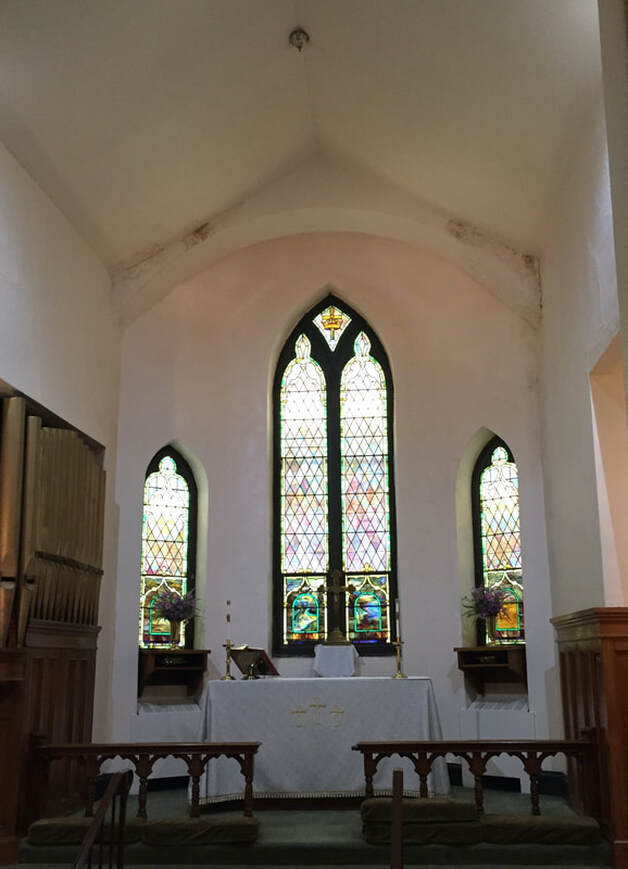 The arch above our altar, showing heavy plaster discoloration due to moisture intrusion through the parapet roof flashings. Blistering is also visible in the wall to the right.
The arch above our altar, showing heavy plaster discoloration due to moisture intrusion through the parapet roof flashings. Blistering is also visible in the wall to the right.
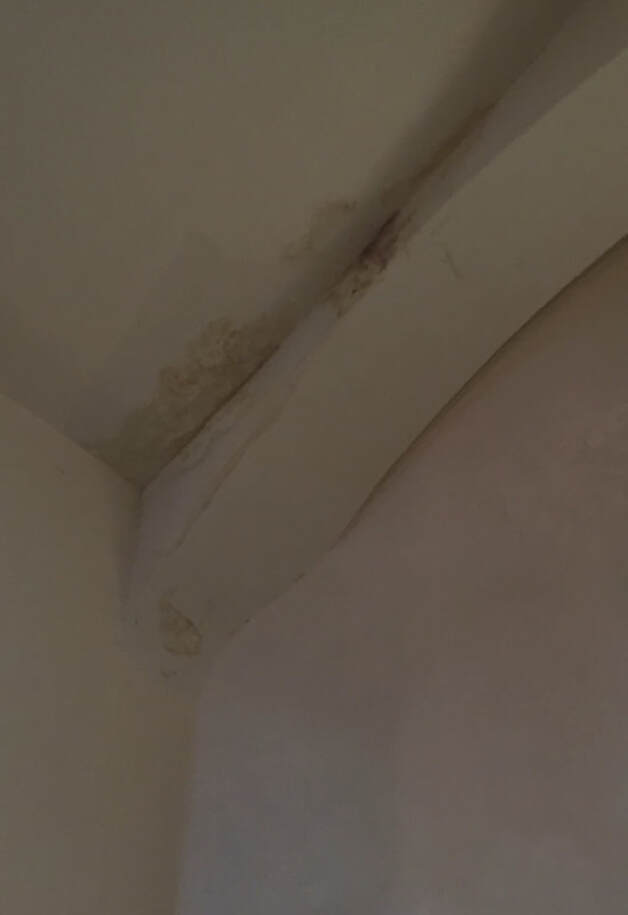 Close-up view of the left side of the arch above the altar. Portions of the wall beneath this arch were moist to the touch after recent rainstorms, indicating an acute problem.
Close-up view of the left side of the arch above the altar. Portions of the wall beneath this arch were moist to the touch after recent rainstorms, indicating an acute problem.
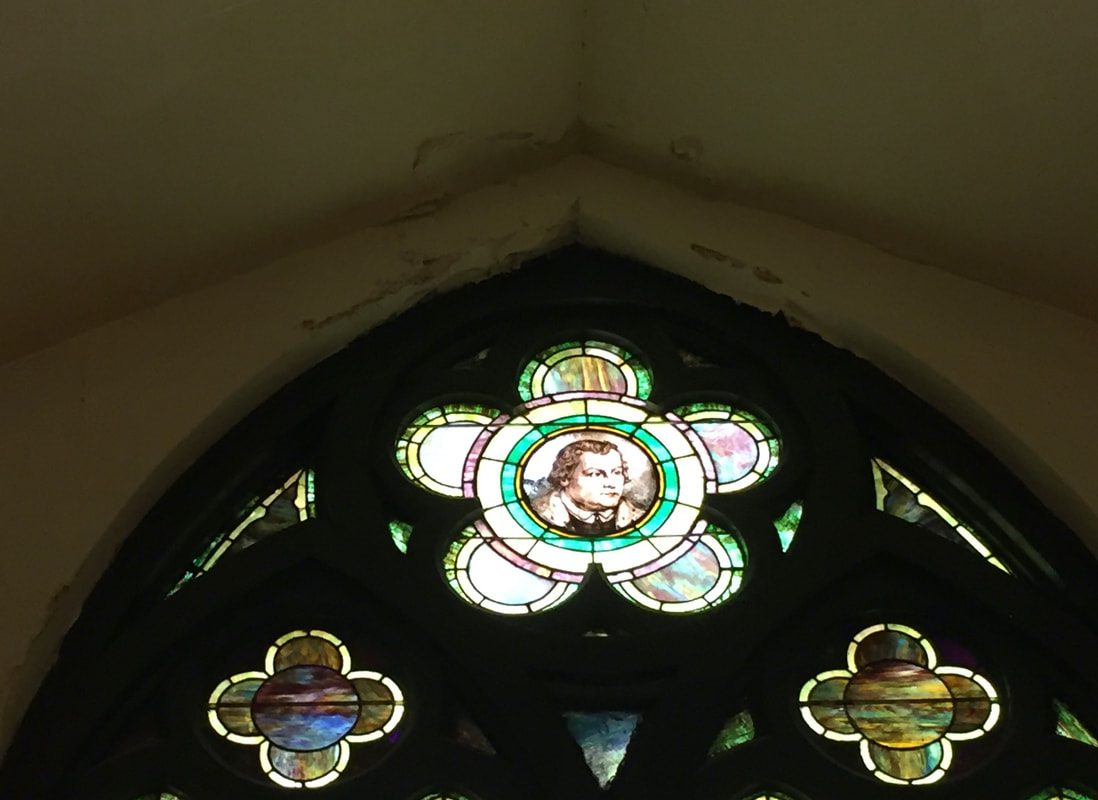 Deterioration of the plaster above the Martin Luther window, on the north side of our sanctuary.
Deterioration of the plaster above the Martin Luther window, on the north side of our sanctuary.
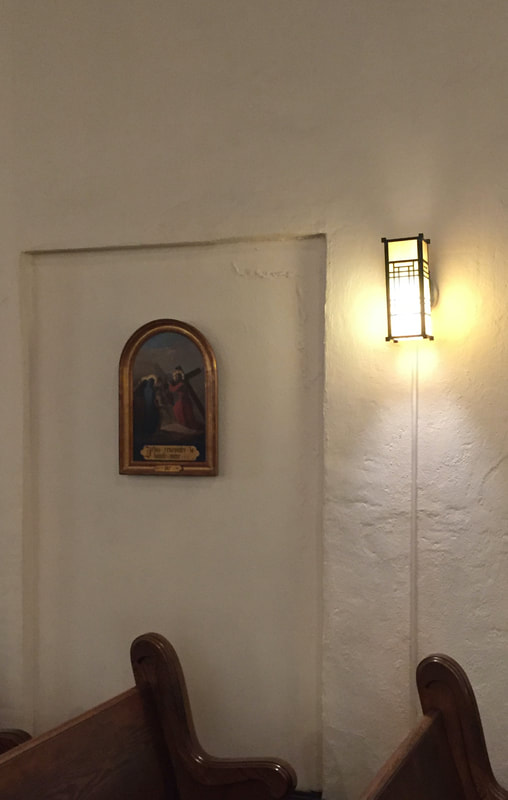 Blistering in the plaster walls, due to moisture, on the north wall of the sanctuary. Note, also, the above-surface wiring conduit to the light fixture, which detracts from the historic space.
Blistering in the plaster walls, due to moisture, on the north wall of the sanctuary. Note, also, the above-surface wiring conduit to the light fixture, which detracts from the historic space.
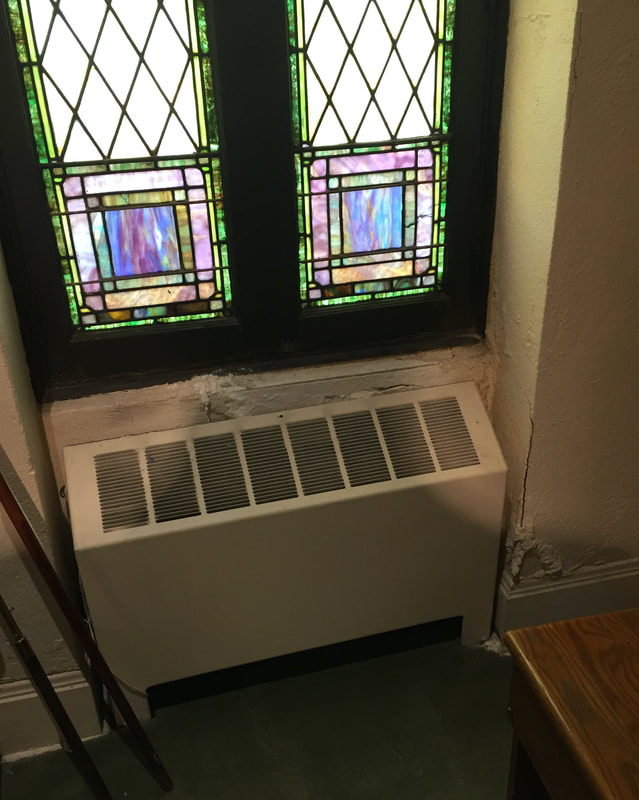 Plaster deterioration due to moisture, seen around the window to the left of our 1919 Moller organ (front of sanctuary).
Plaster deterioration due to moisture, seen around the window to the left of our 1919 Moller organ (front of sanctuary).